This page contains affiliate links. Please read our disclosure for more info.
Japan is a bewildering, beautiful country that is like nowhere else. There are so many amazing things to do in Japan that one trip is never enough—it has stolen our hearts and we can’t stop returning.
From ancient temples to futuristic skyscrapers, tranquil tea ceremonies to over-the-top arcades, relaxing hot springs to cosplay go-kart rides, Japan has so much to offer everyone.
In this post, I share the best things to do in Japan divided into the categories Culture (for unique things you can only do in Japan), Fun (for all the quirky and futuristic stuff), Food (because the food is extraordinary and you must eat as much as possible), Spiritual (for all those wonderful temples and shrines) and Beautiful (for the gorgeous natural scenery).
Even on a short visit to Japan, you can choose a few experiences from each category for an unforgettable trip.
Contents
- Video: Best Things to Do in Japan
- Cultural Things to Do in Japan
- Fun Things to Do in Japan
- Best Japan Activities for Foodies
- Spiritual Things to Do in Japan
- Best Beautiful Japan Attractions
- Planning Your Japan Itinerary
- Japan Travel Tips
Video: Best Things to Do in Japan
Watch our short video for ideas on what to do in Japan for an amazing trip.
Cultural Things to Do in Japan
These unique things to do in Japan are activities you don’t find elsewhere and are the best ways of experiencing Japanese culture.
1) Spend a Night in a Ryokan
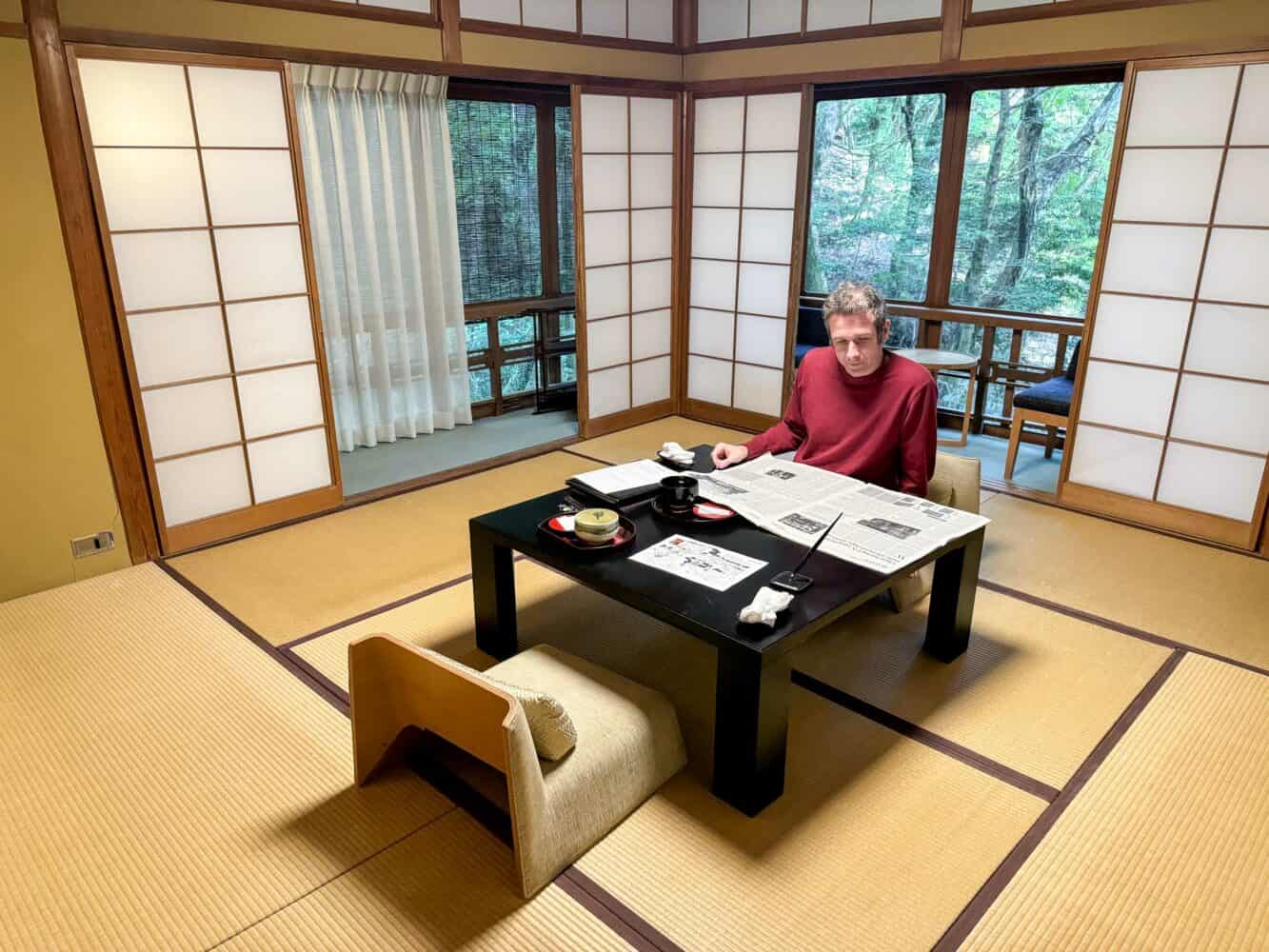
For at least one night of your trip, I highly recommend staying in a ryokan, which is a traditional Japanese inn.
Tatami mat rooms are elegant, minimalist spaces, usually with just a table and low chairs where you can enjoy green tea on arrival.
Breakfast and dinner are often included in the price and served in your room. The epic, multi-course meals are a highlight of a stay in a ryokan and have been some of our best meals in Japan.
Ryokans can often cater to vegetarians and vegans, but let them know any dietary requirements in advance (you don’t get a choice of dishes).
After dinner, futons will be set up on the floor and can be surprisingly comfortable to sleep on.
Ryokans range from simple (such as guesthouses called minshuku) to ultra-luxurious, sometimes with private baths and views overlooking exquisite Japanese gardens.
They are more expensive than regular hotels but are well worth it for the experience.
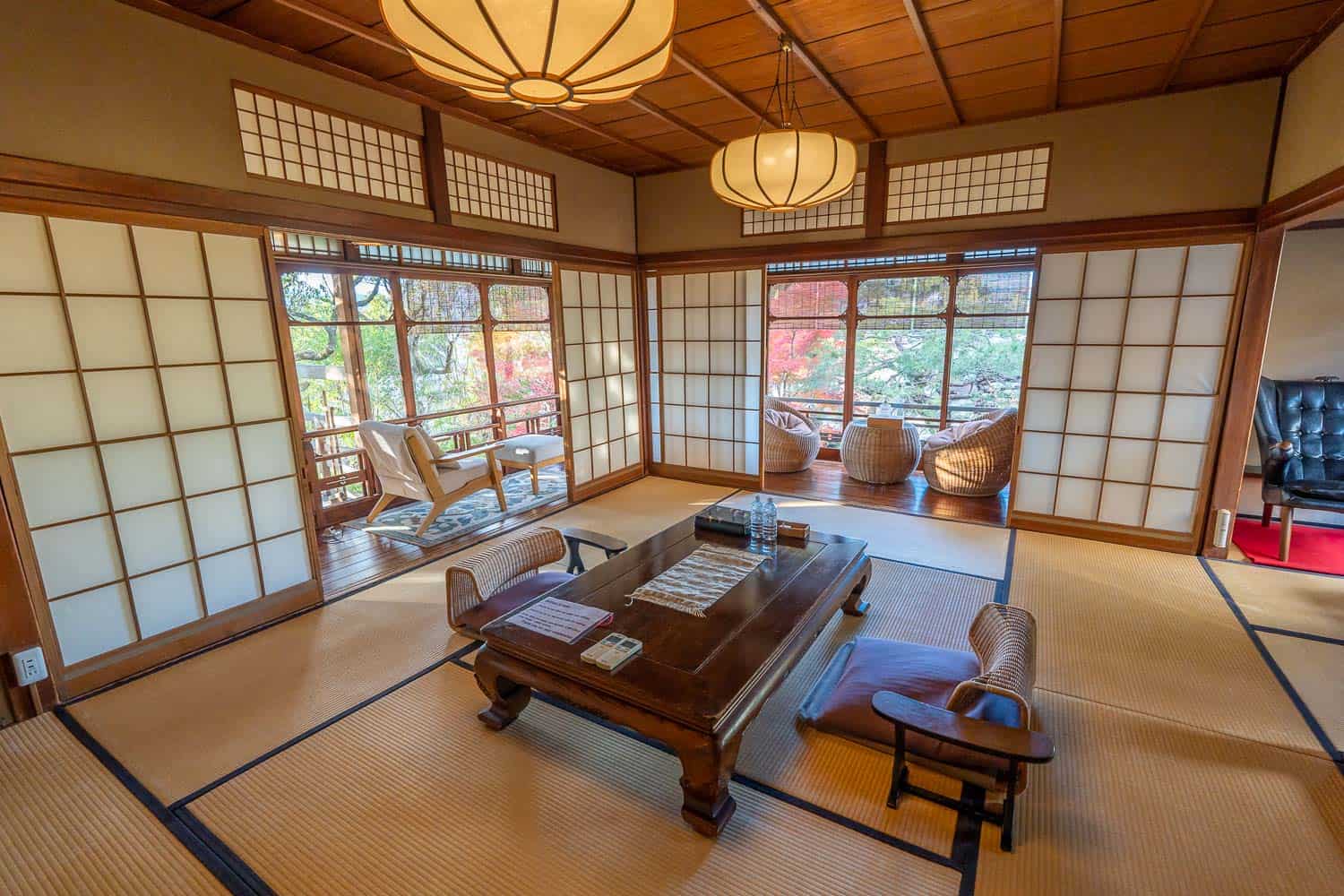
Our favourite ryokans are:
- Tsukihitei – A traditional inn near the temples in Nara with a magical forest setting.
- Iwaso – A beautiful ryokan in a secluded but convenient location on Miyajima Island, ideal for exploring once the day trippers have left.
- Nanzenji Ryokan Yachiyo – Our huge suite at this Kyoto ryokan had a private bath overlooking the scarlet maple trees in the garden. See our guide to where to stay in Kyoto for a detailed review.
You can find many other ryokans all over Japan—search on Booking.com.
2) Soak in an Onsen
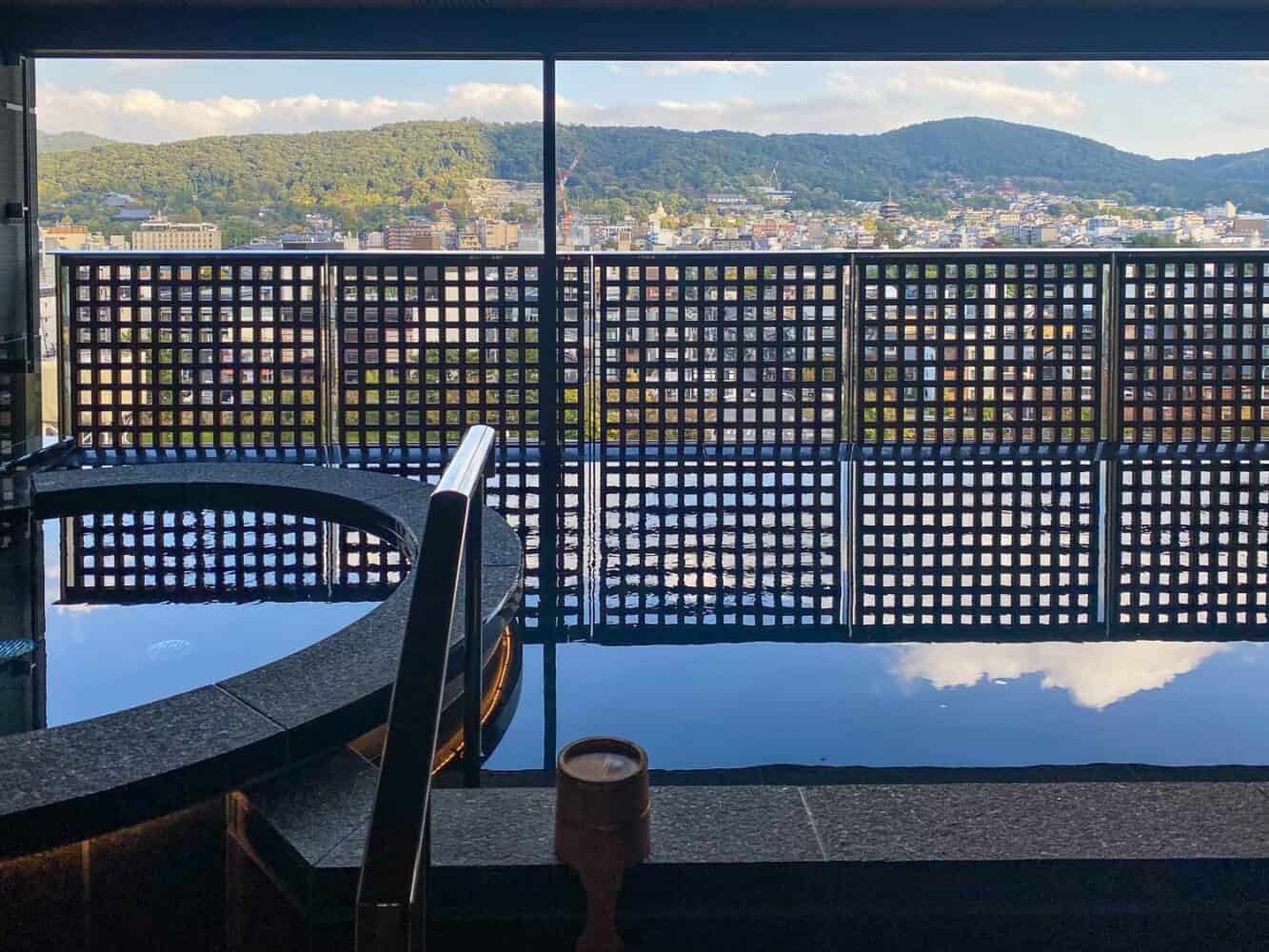
The classic Japanese experience is soaking in the steaming hot waters of an onsen (hot spring bath)—it’s a must for your Japan bucket list.
Onsens come in many forms—indoor and outdoor, simple and luxurious, small and large. Most of them are shared, but some ryokans have private baths you can reserve.
Most ryokans have onsens, but you can also find them at some Western-style hotels (we loved the rooftop one at Sora Niwa Terrace in Kyoto). Or public onsens offer access for a fee.
Onsens can be a challenge for foreigners (they were for us at first!), as you must be completely naked (most are divided by gender).
Make sure you shower thoroughly before you get in the bath. It’s worth getting over your fears as they are such a relaxing experience.
Soaking in onsens is one of the best activities to do in Japan in winter. In summer, the hot water is less appealing.
3) Wander Around an Onsen Town in a Kimono
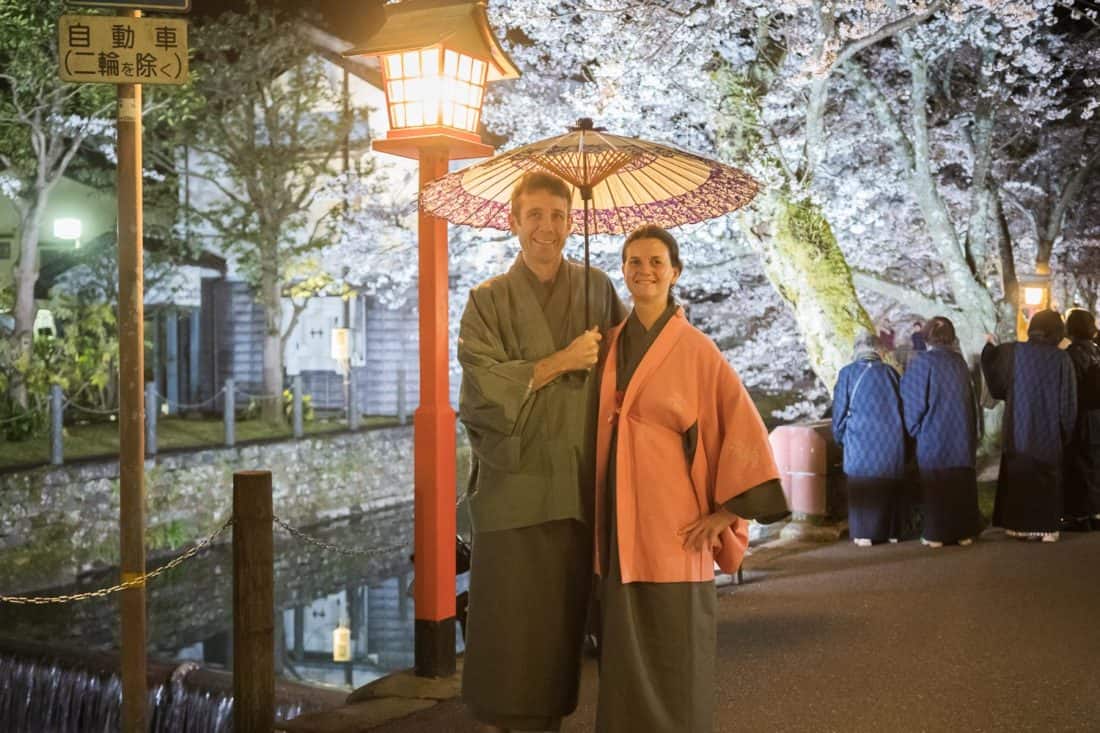
If you want the full onsen experience, head to an onsen town.
These small resort towns are usually in rural settings and feature many different onsens. They are popular destinations for the Japanese for relaxing getaways.
The best way to experience one is to stay in a ryokan. Some have their own onsens and usually include a pass to visit the other onsens in town.
After putting on the provided yukata (cotton kimono) and geta (wooden sandals), you head out to hop from one onsen to another and relax in the steaming waters.
There are many onsen towns in Japan. We loved Kinosaki Onsen, which is easily accessible from Kyoto and Osaka and is particularly pretty in the spring when the canals are lined with cherry blossoms.
We stayed at the friendly Morizuya Ryokan which has two small onsens available for private use in the afternoon—perfect for your first time.
Read more about Kinosaki Onsen and onsen etiquette.
4) Watch a Geisha Dance
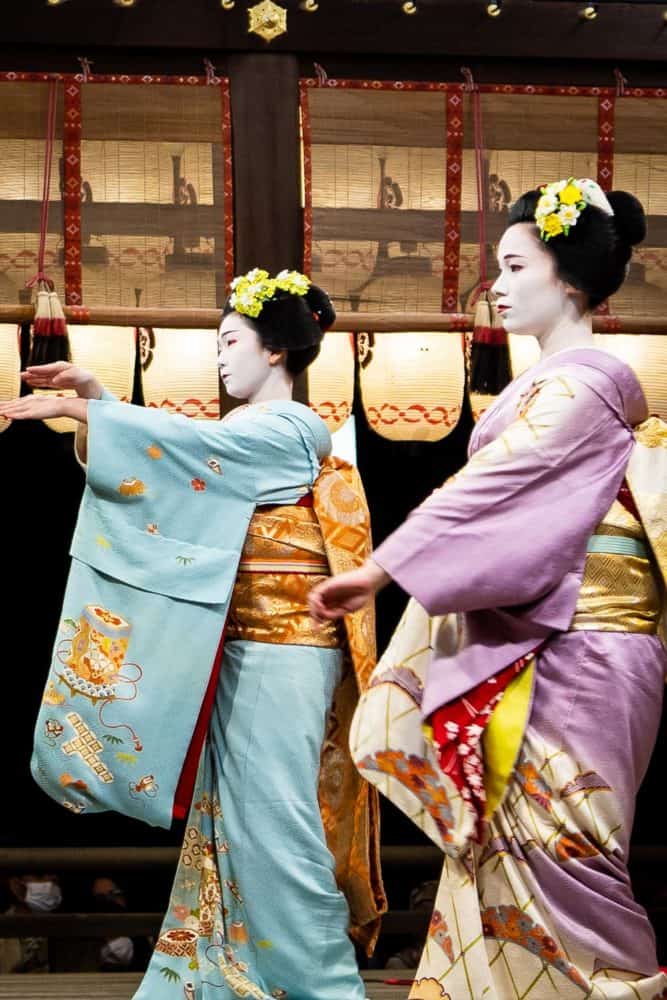
Geishas are one of the most fascinating aspects of Japan, especially if you’ve read Arthur Golden’s popular novel Memoirs of a Geisha about these highly-skilled women who entertain using traditional arts.
It’s hard to believe they still exist, but when we spent a month living on a traditional street in Miyagawacho in Kyoto (near the more well-known Gion area), we often saw them in brightly coloured kimonos emerging from wooden teahouses.
Rather than stalking geisha on the streets of Gion, I recommend watching them perform at one of the annual dances that take place every spring and autumn.
The most famous is the Miyako Odori in April, but we went to the Kyo Odori instead, which doesn’t attract many foreign guests. It’s one of our absolute favourite things to do in Kyoto.
We also enjoyed the Gion Odori in early November.
The performances are spectacular, and it is fascinating to get a closer look at the extravagant kimono, ornate hairstyles, and iconic white makeup these graceful women wear.
Another option any time of year is to take a night walk in Gion with a local guide to learn about the history of geisha and perhaps encounter one.
Top tip: Miyagawacho is the perfect area to stay in Kyoto for spotting geisha without the crowds of Gion. We rented a studio on Vrbo that’s no longer available, but other options include this incredible samurai machiya, ideal for large groups.
5) Admire Ukiyo-e Prints
Ukiyo-e or Japanese woodblock prints are uniquely Japanese and flourished during the Edo Period from the 17th to 19th centuries.
The prints depict landscapes, regular life of ordinary people, and popular kabuki actors, sumo wrestlers, and geisha from the world of entertainment or “floating world”.
You can see ukiyo-e in many cities in Japan. We enjoyed the small Ota Memorial Museum in Harajuku (one of our favourite things to do in Tokyo), which displays rotating exhibitions—we were lucky enough to see the 36 Views of Mount Fuji by Hokusai including the famous Great Wave off Kanagawa.
6) See Sumo Wrestlers in Action
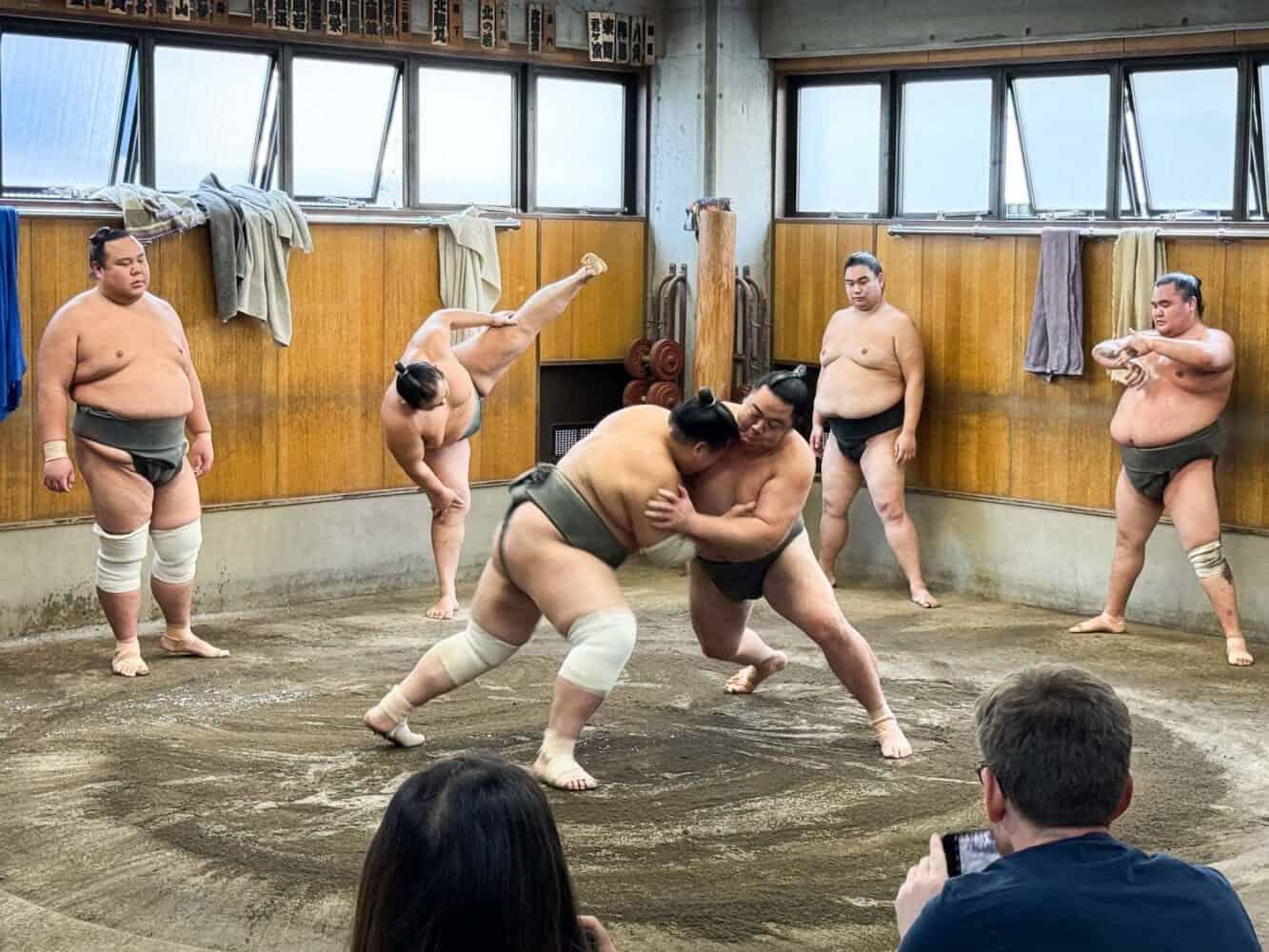
Sumo is serious in Japan and the national sport is steeped in tradition. Matches still include rituals that date back to its ancient origins as part of the Shinto religion such as purifying the ring with salt.
You can see sumo wrestling at one of the sumo tournaments that happen a few times a year. Tournaments happen in Tokyo in January, May and September, and in Osaka in March.
We’ve never got the timing right, so on our last trip, we took this tour to a sumo stable in Tokyo to see the wrestlers’ morning training session. It was such a fascinating and intimate experience seeing the immense sumotori up close.
I loved the novel The Street of a Thousand Blossoms by Gail Tsukiyama, which gave me a greater insight into sumo culture.
7) Watch a Kabuki Performance
Kabuki is a form of traditional Japanese theatre that dates back to the Edo Period. It includes drama, dance and music and the all-male performers wear elaborate makeup.
The best place to see a Kabuki performance is the Kabukiza Theatre in Ginza, Tokyo, which offers single act tickets (performances last hours otherwise) and English captions are available.
You might find performances in other major cities.
9) Dress Up as a Geisha
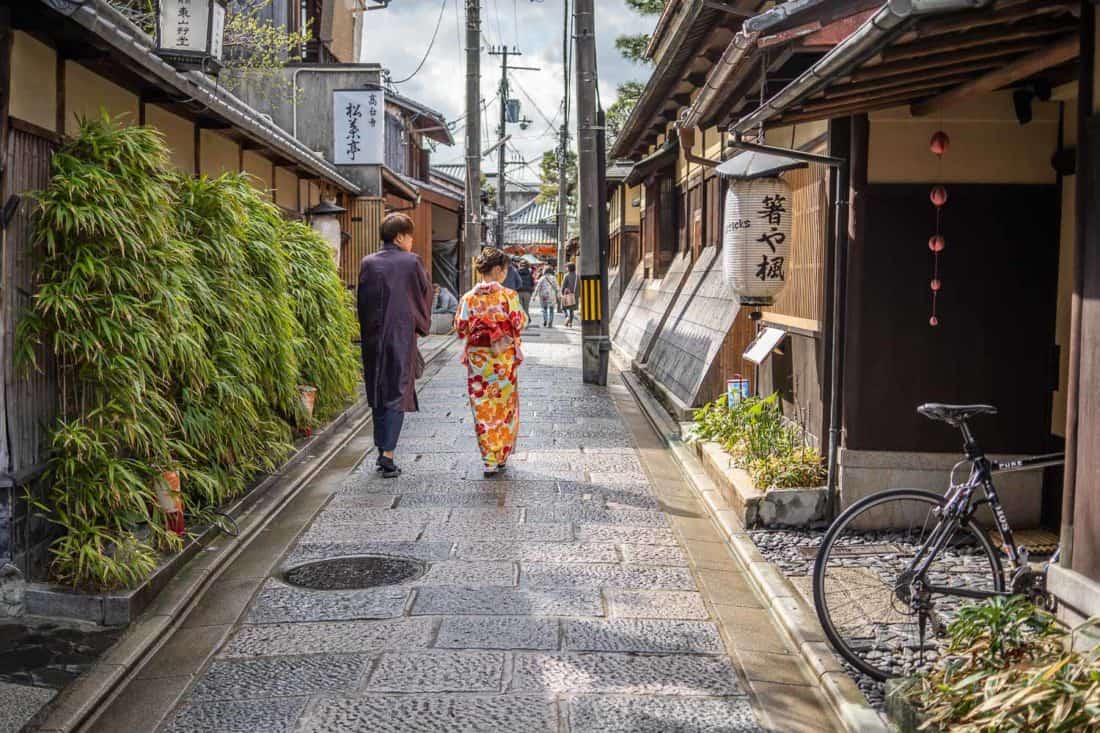
Hiring a kimono for the day and wandering the historic streets of Gion and Higashiyama is a popular activity in Kyoto with both Japanese and foreigners.
There are many shops in Gion and the surrounding areas to rent them (the Yasaka Shrine area is a convenient place to start). Check out this kimono rental shop (including optional hairstyling).
Another option if you want a more extravagant maiko outfit is this Maiko Makeover with professional studio photos.
Although Kyoto’s ancient streets are the most common place to rent a kimono, you can find rental shops throughout Japan.
10) Gaze at Itchiku Kubota’s Stunning Kimonos
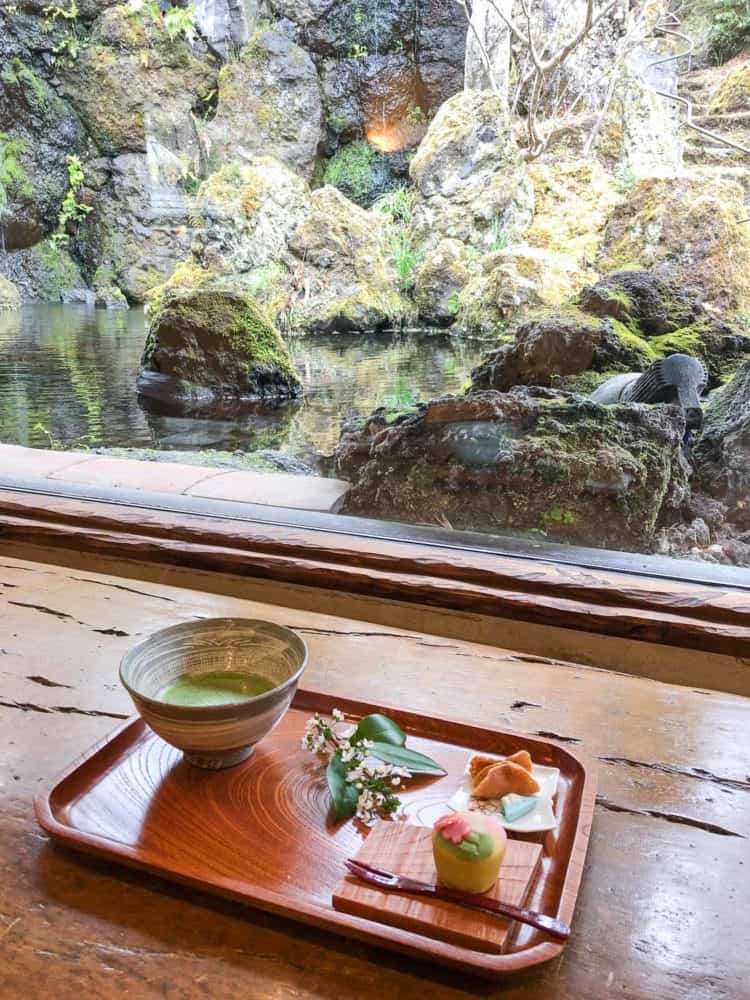
On a cloudy day at Kawaguchiko (when Mt Fuji did not emerge), we came across the Itchiku Kubota Art Museum on the shores of the lake.
We didn’t expect much from a kimono museum, but Itchiku Kubota’s oversize kimonos are exquisite works of art and we were blown away.
Kubota made it his life’s mission to recreate a lost textile dyeing technique from the 16th century and the results are stunning.
His kimonos are full of colour and texture and depict nature such as the changes in Mount Fuji through the seasons.
This museum isn’t on many things to do in Japan lists, but I think it’s a hidden gem, especially if you visit the beautiful onsite teahouse too.
See our Lake Kawaguchiko travel guide for more tips on the area.
11) Pay Your Respects at the Hiroshima Peace Museum
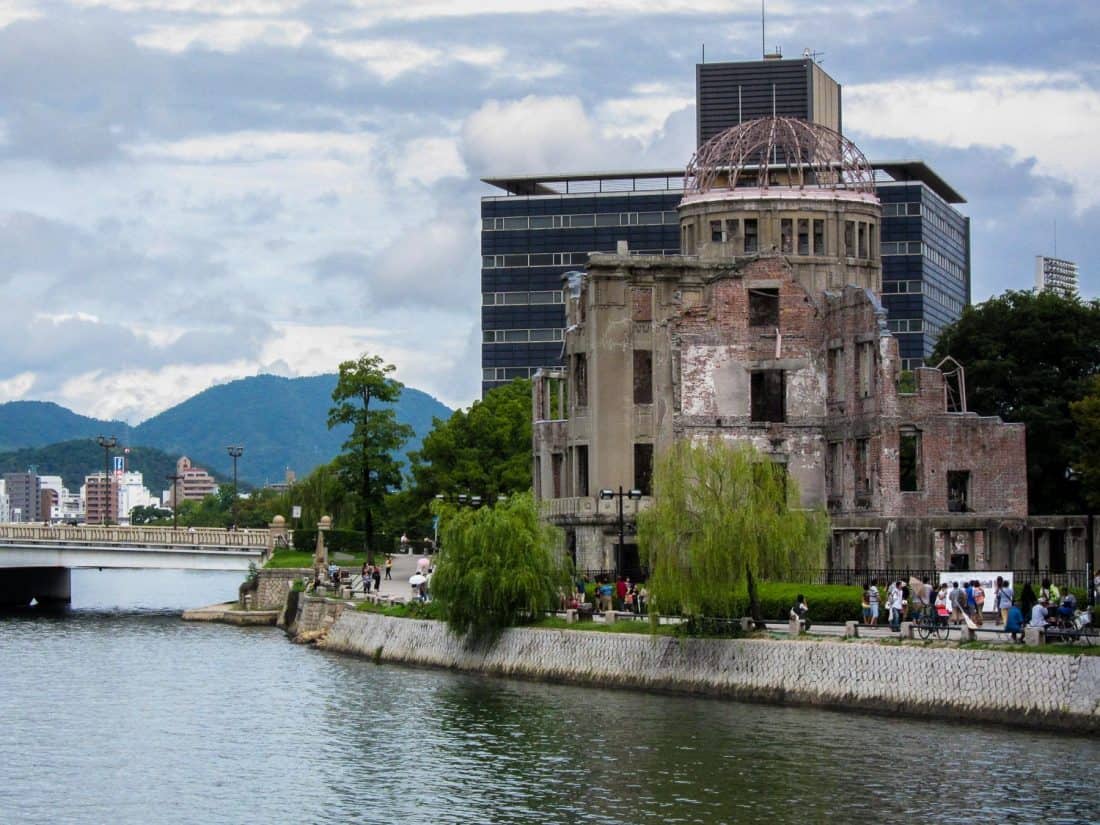
Head to Hiroshima to pay your respects to the victims of the atomic bombing at Hiroshima’s moving Peace Memorial Park.
The park is beautiful and the museum is heartbreaking, riveting, and vitally important.
Afterwards, explore the modern city that was almost entirely rebuilt after World War II.
Recommended Reading: 16 Unmissable Places to Visit in Japan
Fun Things to Do in Japan
12) Ride a Shinkansen (Bullet Train)
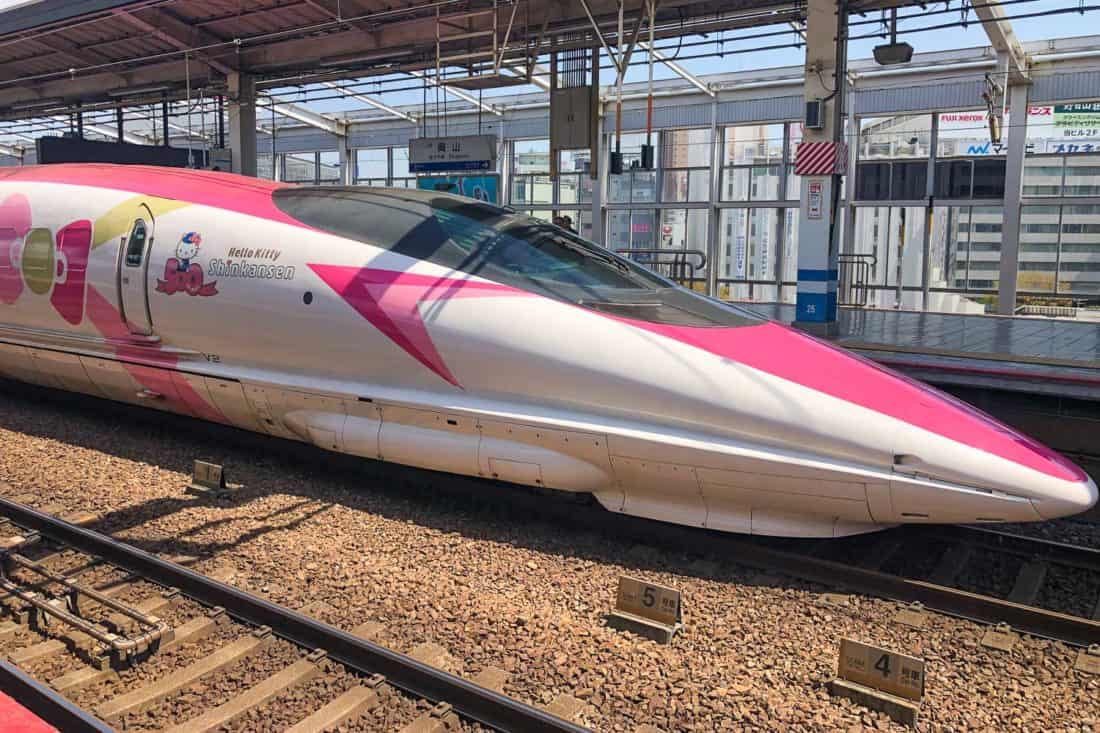
We adore train travel in Japan. The network is extensive and the trains are comfortable, clean, quiet, safe, and always on time (to the minute!).
Best of all are the shinkansen or bullet trains which travel at ultra-high speeds of up to 320 km/h (199 mph).
They make travelling between major cities very fast—Tokyo to Kyoto, a distance of 450km (280 miles) can be covered in 2 hours 15 minutes by the fastest shinkansen Nozomi.
You can even ride fun themed bullet trains such as the Hello Kitty shinkansen which runs from Osaka to Fukuoka.
Shinkansen are expensive but worth it. A Japan Rail Pass used to make them more affordable, but that’s less clear cut after a major price increase (the pass is still so convenient, though). Our guide to Is a Japan Rail Pass Worth it? will help you decide.
13) Go-Kart Around Tokyo
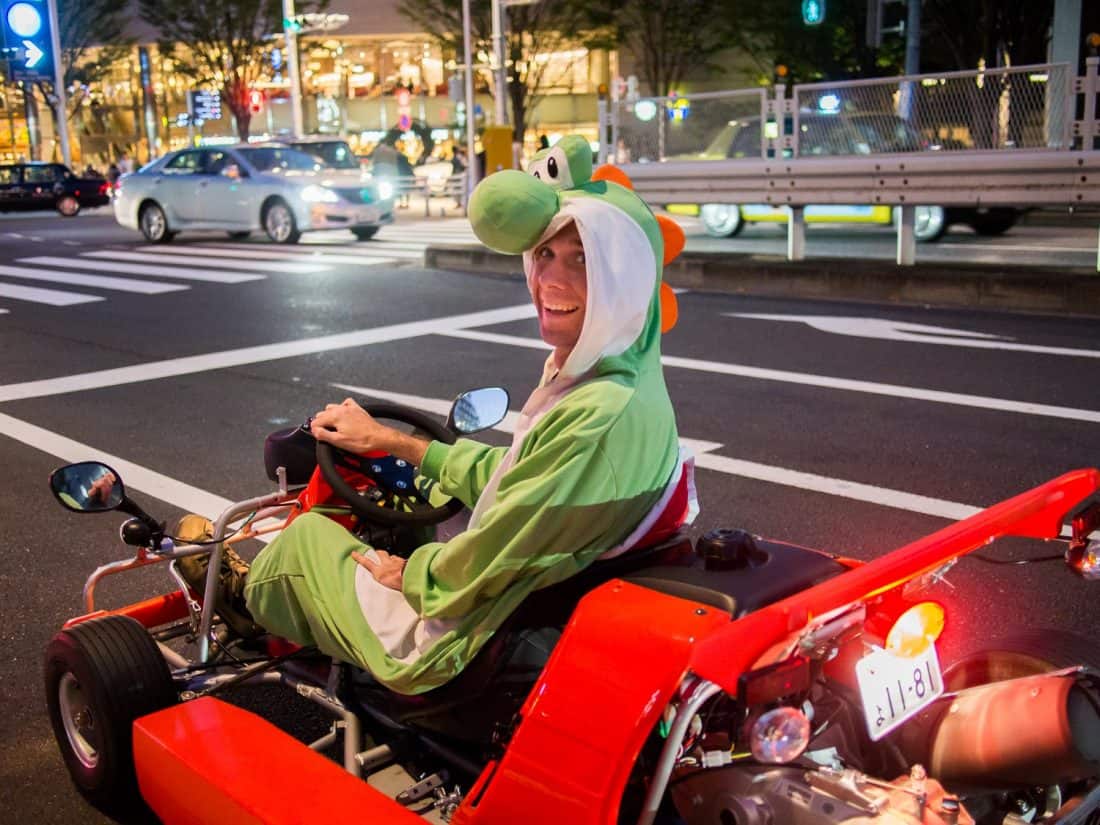
Go-karting in Tokyo tops our list of the most fun things to do in Japan! Where else in the world can you dress up as your favourite character and drive go-karts on the real streets of a major city?
I was terrified at first as we drove alongside buses and cars but ended up having so much fun!
You used to be able to dress up as Mario characters but Nintendo shut that down. You’ll still have a range of costumes to choose from.
Important: Make sure you get an international driving permit from your home country before you come to Japan as they are strict about this requirement.
Check out the Tokyo go-karting tour here.
14) Enjoy a Day at DisneySea
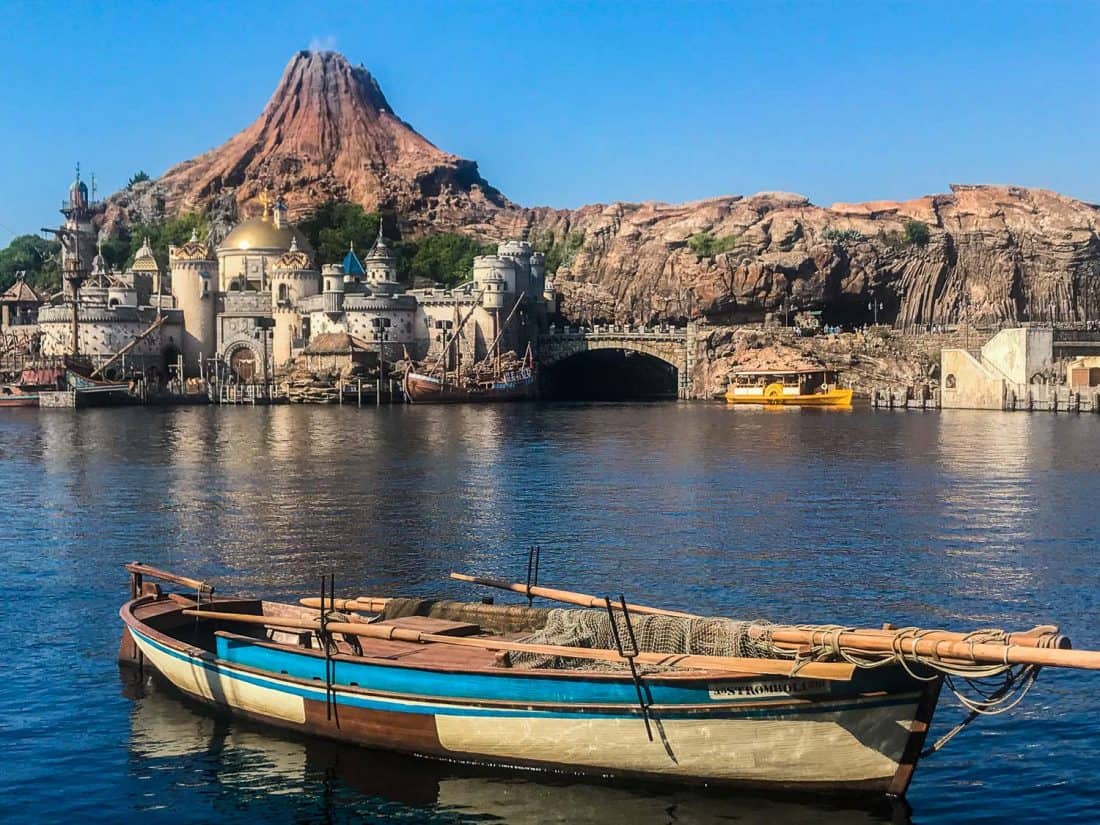
DisneySea is one of the best Disney parks in the world with a unique nautical theme featuring ports like Mysterious Island with an erupting volcano, Mediterranean Harbor which looks just like Italy, and the huge new expansion, Fantasy Springs.
There are many fun rides at DisneySea as well as more adult-orientated attractions like seeing a Broadway show or drinking a cocktail in a 1920s lounge aboard a cruise liner.
You have to book park tickets in advance, and the Tokyo Disney site often doesn’t work with international cards, so we buy tickets from authorised agent Klook and just show a QR code to enter.
Disney is easily accessible from central Tokyo in about 30 minutes, but we prefer to stay close by to avoid rush hour travel and be able to take a break during the day.
Hotel Mystays Maihama is a budget option in walking distance, but our favourite place to stay in all Japan is the Hotel MiraCosta, right inside Tokyo DisneySea (it’s pricey though).
I definitely recommend staying nearby if you want to visit the neighbouring Disneyland Tokyo park as well as you’ll need two full days.
15) Head up High for a City View
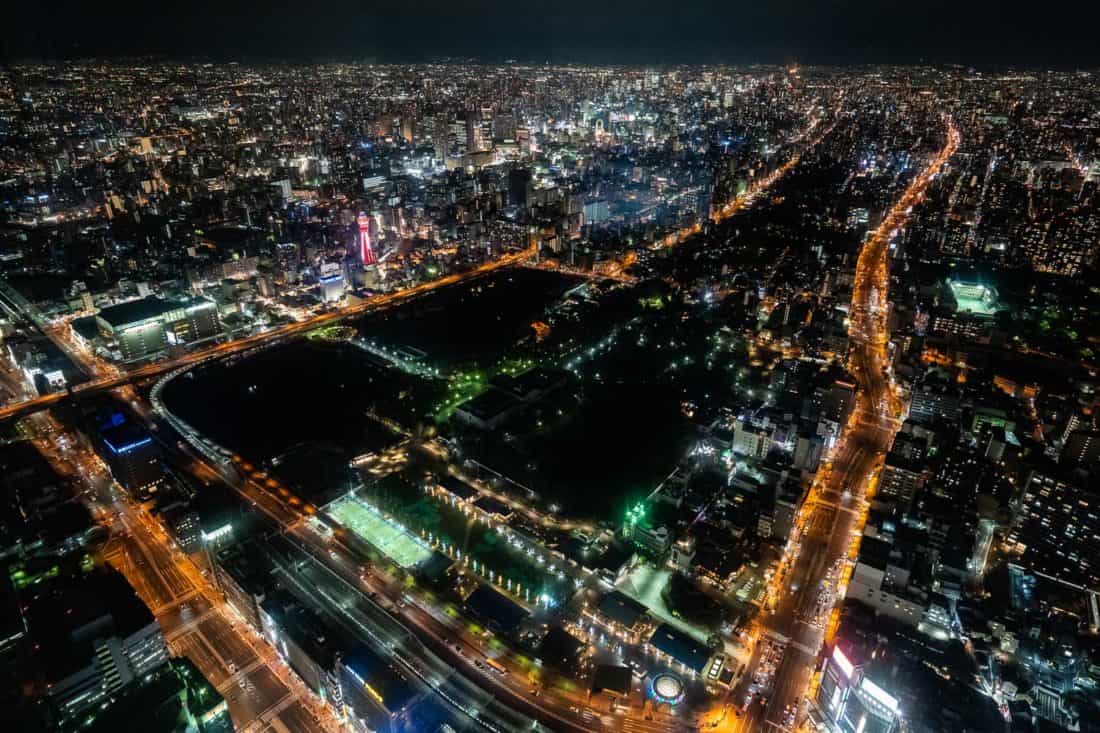
Japanese cities are vast and impressive with towering skyscrapers and neon signs. I think they are best admired from above at night, so head up to an observatory in one of the tall buildings.
One of my favourite observatories is Harukas 300 in Osaka which has 360º views from the floor-to-ceiling windows and a cool open-air garden bar.
In Tokyo, the best view is from Shibuya Sky (book four weeks ahead for the prime sunset spot).
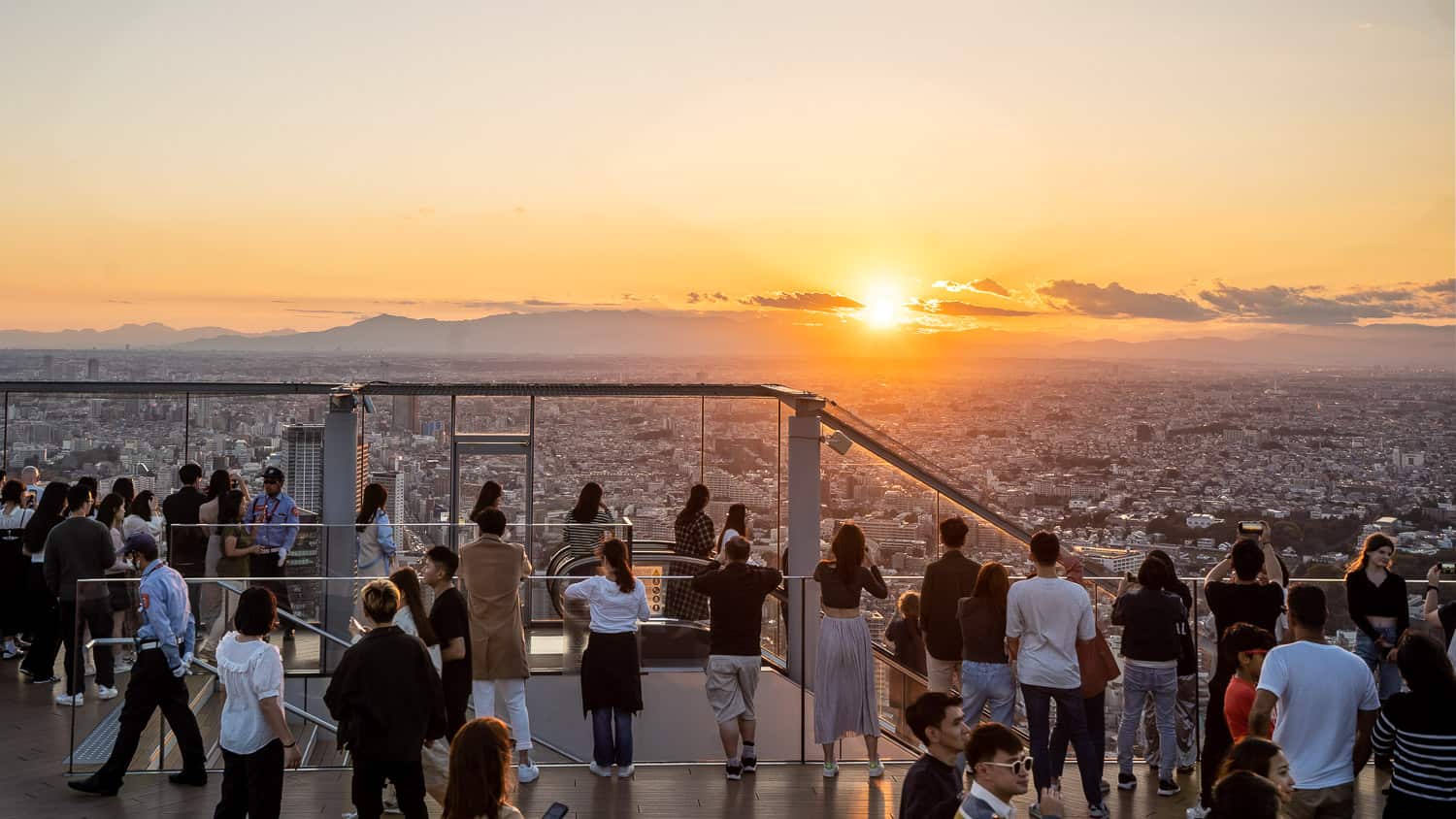
You can also get a free view from the Tokyo Metropolitan Government Building in Shinjuku.
16) Rent a Karaoke Booth
Karaoke is one of the most typical Japan activities—everyone from teenagers to businessmen loves it.
But don’t worry if you are shy—there’s no need to sing in public as in Japan you rent a private booth in one of the many huge karaoke buildings.
The rooms are equipped with comfy seating, microphones, TV, and a tablet which you use to choose from a wide selection of songs. You can even order drinks and food.
We went to a branch of the budget Karaoke no Tetsujin chain in Tokyo and were surprised that the cost included a drink—it makes an affordable night out.
17) Be Spirited Away at Studio Ghibli Museum or Park
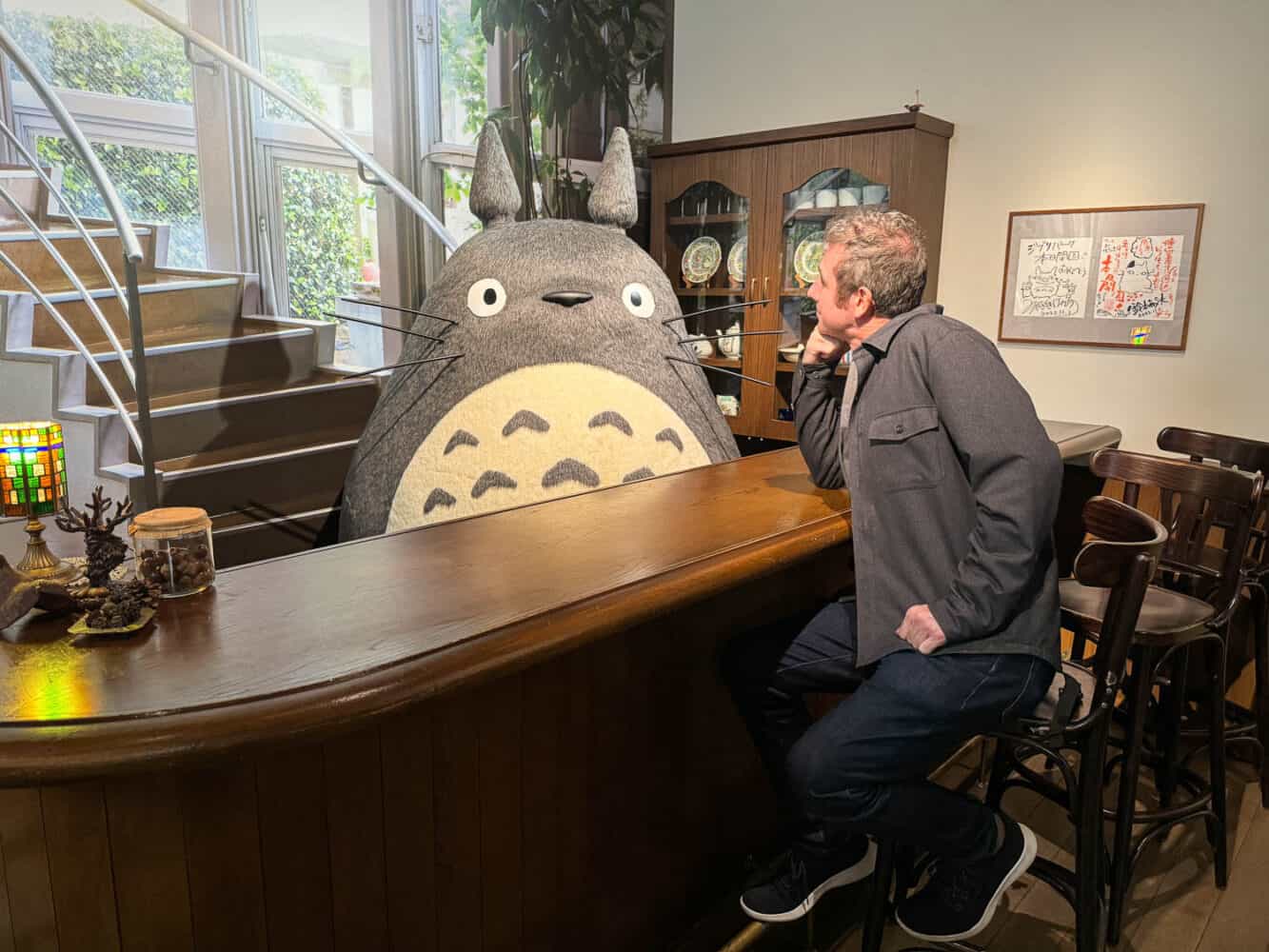
If you are a fan of Studio Ghibli films like Spirited Away and My Neighbor Totoro, don’t miss the whimsical Studio Ghibli Museum in Tokyo where you can see props and drawings from the animations in a quirky building.
You must buy your tickets on the 10th of the month for the following month—see the Ghibli Museum website for details.
Even better, visit the new Ghibli Park near Nagoya. The theme park doesn’t contain any rides but is an immersive experience in the world of Studio Ghibli films.
We visited as a day trip from Kyoto and loved all the fun photo opportunities. See our detailed Ghibli park review for everything you need to know (including how to score tickets).
Recommended Reading: 26 Cool Things to Do in Tokyo
18) Enter the World of Harry Potter at Universal Studios Japan
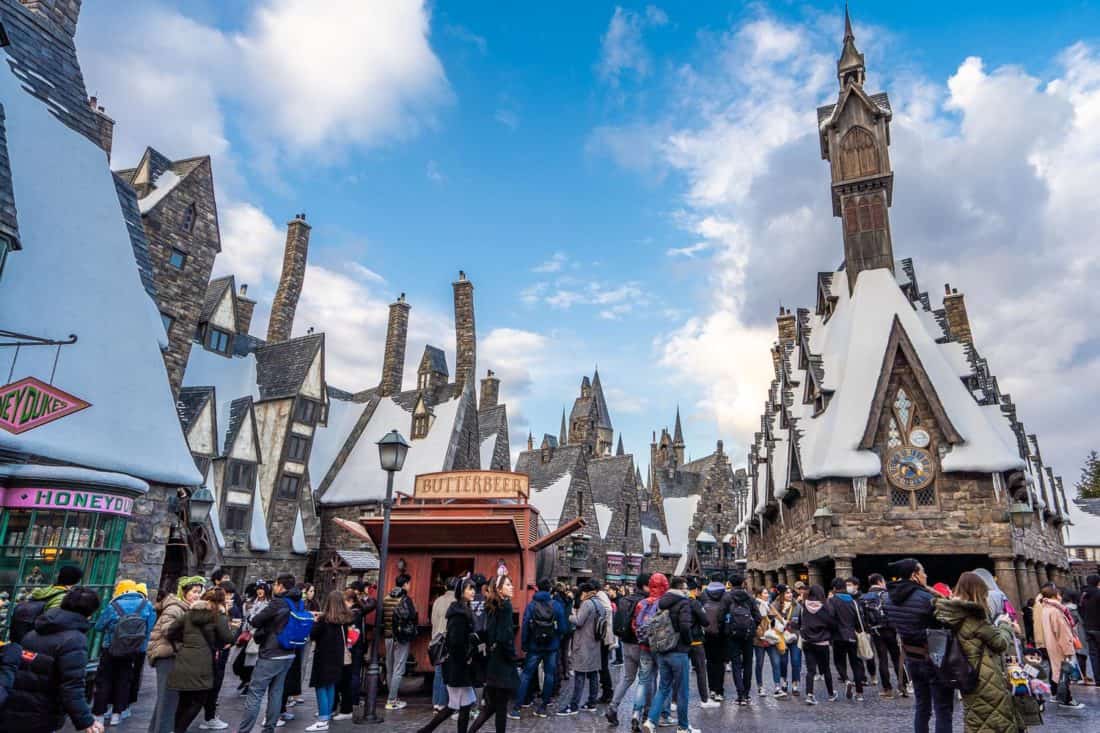
Universal Studios Japan in Osaka is a must for Harry Potter and theme park fans.
The highlight is the immersive Wizarding World of Harry Potter where you can wander the snowy cobbled streets, stroll through Hogwarts, drink butterbeer, shop for sweets in Honeydukes, and even cast your own spells if you buy a magic wand.
Elsewhere in the park, there are plenty of rides for thrill-seekers including Hollywood Dream and The Flying Dinosaur—the scariest rollercoaster I’ve ever been on!
Super Nintendo World is also amazing (including the new Donkey Kong Country). Note you will likely need a free timed entry ticket (or Express Pass) to enter this area.
See our favourite Universal Studios Japan rides.
The park gets extremely busy, so avoid weekends and buy your tickets in advance here from authorised agent Klook.
I also highly recommend purchasing an Express Pass to skip the queues on the most popular rides. I wouldn’t visit the park without one.
19) Experience Sensory Overload at the Robot Restaurant
Update: Robot Restaurant is currently closed. It was due to reopen but no date has been set. In the meantime, the Samurai Restaurant in Shinjuku is run by the same people and offers a similar over-the-top experience.
The Robot Restaurant is one of the weirdest things to do in Japan.
It’s not actually a restaurant but is a bizarre, high-energy show featuring robots, dragons, ninjas, blue-haired dancers, creepy clowns, guitarists on swings, drummers, and lots of flashing neon lights.
It’s incredibly loud, obnoxious, and hilarious.
20) Ride the Don Quixote Ferris Wheel in Dotonbori
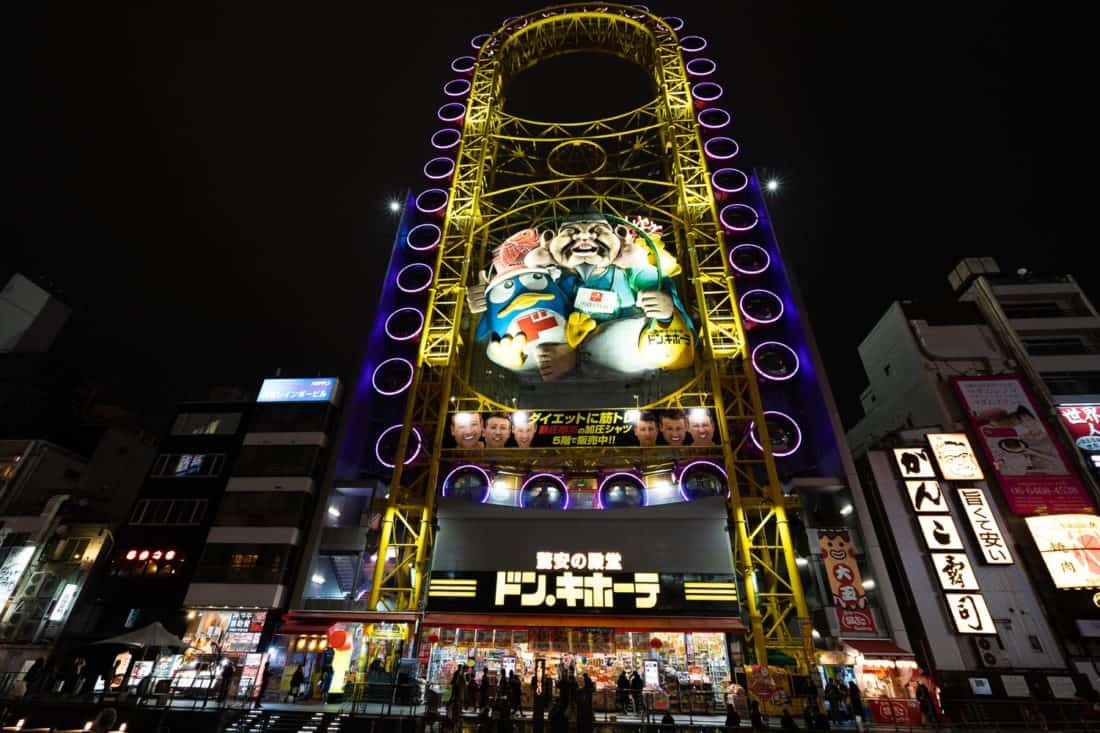
A nighttime visit to Osaka’s Dotonbori neighbourhood is a must-do in Japan with its overwhelming display of neon, giant food models, and many restaurants and food stalls.
Overlooking the river you can ride a unique Ferris wheel in the building of the massive Don Quixote store (great for cheap souvenirs).
Also known as the Ebisu Tower Ferris Wheel, it’s the strangest looking Ferris wheel as it’s built onto the facade of the store and you ride in a capsule that follows an oval shape up to 77 metres high with views of the river and city.
Top tip: We recommend staying in the Shinsaibashi neighbourhood of Osaka. It’s walkable to Dotonbori but is in a much quieter area with some great shops and restaurants nearby. Search for accommodation in Shinsaibashi here.
21) Play Taiko Drums in an Arcade
There are so many video game arcades in Japan that you won’t be able to miss them (they are loud and neon!).
There’s a wide array of games, and one of the most fun is playing the huge Japanese taiko drums.
If you want to play real Taiko drums, you can take a drumming class in Tokyo.
22) Get Lost in a Colourful TeamLab Show
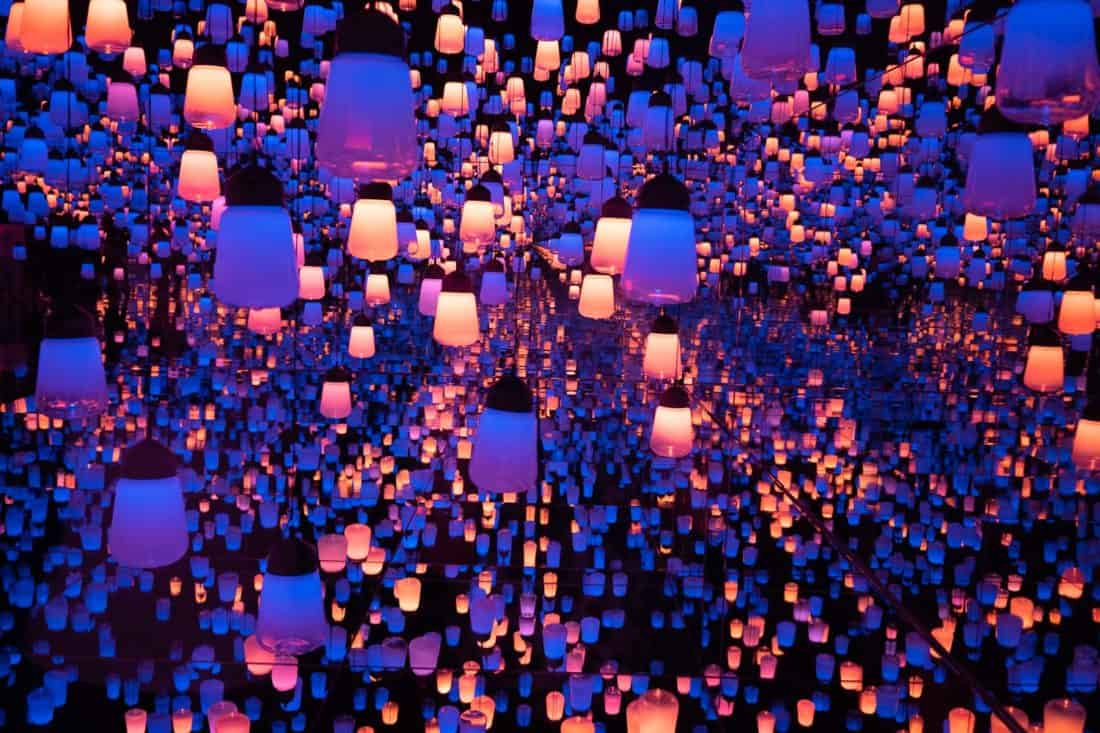
Don’t miss the opportunity to see a TeamLab show in Japan. Their unique digital art museums are immersive experiences where you interact with colourful displays of light and sound.
There are two exhibitions in Tokyo and both are superb.
TeamLab Planets (open until the end of 2027) involves walking in water and a floating orchid garden. There’s also a delicious vegan ramen shop onsite.
Book tickets to TeamLab Planets in advance here. It does sell out. See our TeamLab Planets Tokyo review for everything you need to know including how wet you’ll get (and what to wear).
TeamLab Borderless closed for a few years, but it reopened in a new permanent location in February 2024. It’s even larger than Planets and doesn’t involve water.
23) Brave the Shibuya Crossing
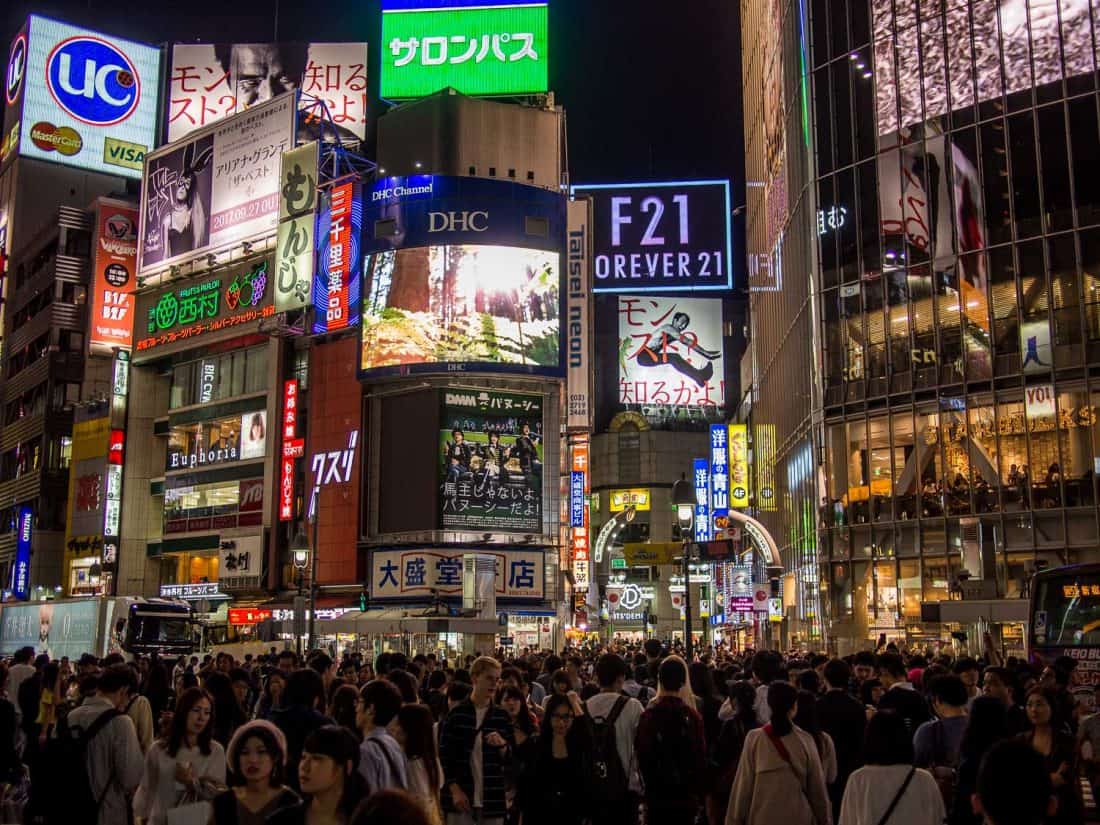
One of the most famous sights in Tokyo is the insane Shibuya Crossing, the world’s busiest pedestrian crossing.
Outside Shibuya Station as many as 2500 people cross the road every time the light changes, somehow managing to avoid bumping into each other.
You can head into the crowd yourself or view the action from above in one of the neighbouring buildings (Starbucks is the most popular spot). It looks best at night when all the neon signs are lit up.
The Shibuya Sky observation deck is another great place to see the crossing from above (if rather distantly) as well as 360º panoramic views of Tokyo.
Best Japan Activities for Foodies
Food in Japan is an adventure and an art form. Japanese cuisine is universally delicious and beautifully presented whether you pick up a snack from a 7-Eleven (yes, this is the only country I recommend this) or indulge in multi-course fine dining.
Being a vegetarian can be a challenge if you don’t plan in advance, but follow our vegetarian in Japan tips and you’ll eat some of the best meals of your life.
We love eating in Japan and there are many fun and tasty culinary experiences to enjoy.
24) Order Ramen from a Vending Machine
Ramen, or noodle soup, may have its origins in China, but there’s now a no more classic Japanese food experience than enjoying a steaming bowl of ramen.
Not only is it utterly delicious, but it’s also one of the quickest and cheapest meals you can find.
In the simplest ramen joints, you make your selection and pay at a vending machine at the entrance and then hand over your ticket to the chef behind the counter who will cook the soup of your choice.
Most ramen is made with meat (or occasionally fish) broth and topped with pork, but vegan ramen is becoming more common.
Read our vegetarian Tokyo and vegetarian Kyoto guides for our favourite veggie ramen joints, and look out for the chains Kyushu Jangara Ramen and Afuri.
25) Try Okonomiyaki
Okonomiyaki is another classic Japanese dish found all over the country but especially in Osaka and Hiroshima.
It’s a thick savoury pancake made with a batter of flour and eggs and filled with cabbage and whatever else you want. Hiroshima-style okonomiyaki also contains noodles.
In some okonomiyaki restaurants, you make your own, while in others it’s made on an iron griddle in front of you. It’s a hearty and inexpensive meal.
Learn to make okonomiyaki on this Osaka cooking class.
26) Take a Cooking Class
A cooking class is one of the best things to do in Japan for foodies as you can learn more about Japanese food culture and take home recipes for your favourite dishes.
There’s a wide variety of cooking classes available in Japan where you can learn to make sushi, ramen, tempura, or regional dishes like Osaka okonomiyaki.
Search for more cooking classes in Japan.
27) Indulge in a Kaiseki Meal
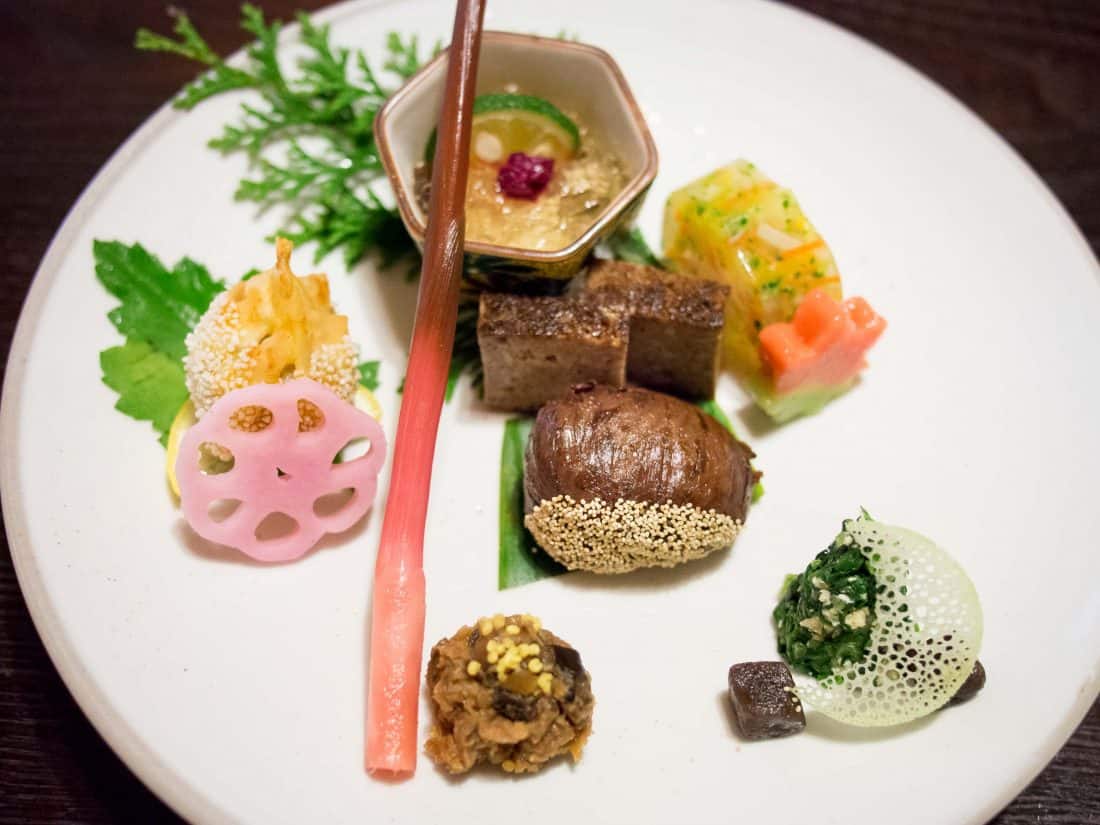
If ramen is one of the cheapest Japanese meals, kaiseki is the most expensive.
Kaiseki is a traditional multi-course meal of the highest quality. A series of small, exquisitely presented dishes are served to guests, usually in beautiful tatami mat rooms. Ingredients are always in season and the presentation enhances the seasonal theme.
Kaiseki meals can be very expensive, but they are a unique experience. Lunch is more affordable than dinner.
If you are vegetarian, look out for the meat-free alternative shojin ryori instead—our favourite place for this is Bon in Tokyo.
28) Drink Matcha with Wagashi
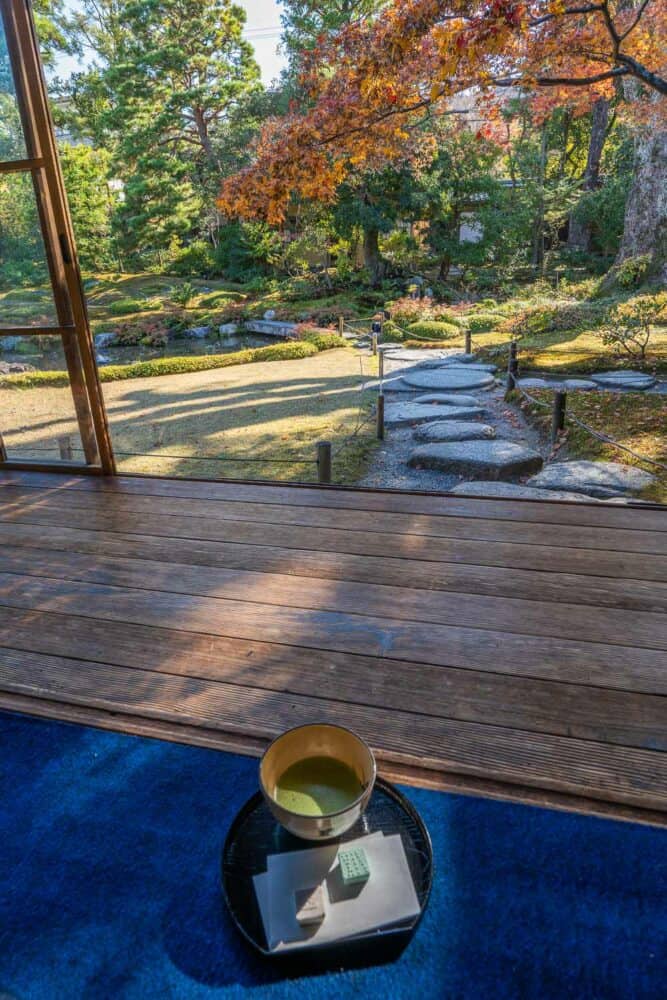
Matcha is a powdered green tea that has a richer flavour than regular tea. A classic Japanese activity is enjoying a bowl of matcha in a traditional tea house accompanied by wagashi, beautiful sweets typically made from rice, red beans, and sugar.
There are many tea houses in Kyoto—we had great experiences at Ippodo Tea Shop and Mandaracha. Many temples and gardens also offer matcha with a view.
We also loved the view from the tea house at Itchiku Kubota Art Museum in Kawaguchiko.
Our ultimate tea adventure was at Sakurai Japanese Tea Experience in Tokyo. The Tea Course at this modern, serene tea house took us on a journey from gyokuro (shaded tea) to matcha.
29) Learn the Art of the Tea Ceremony
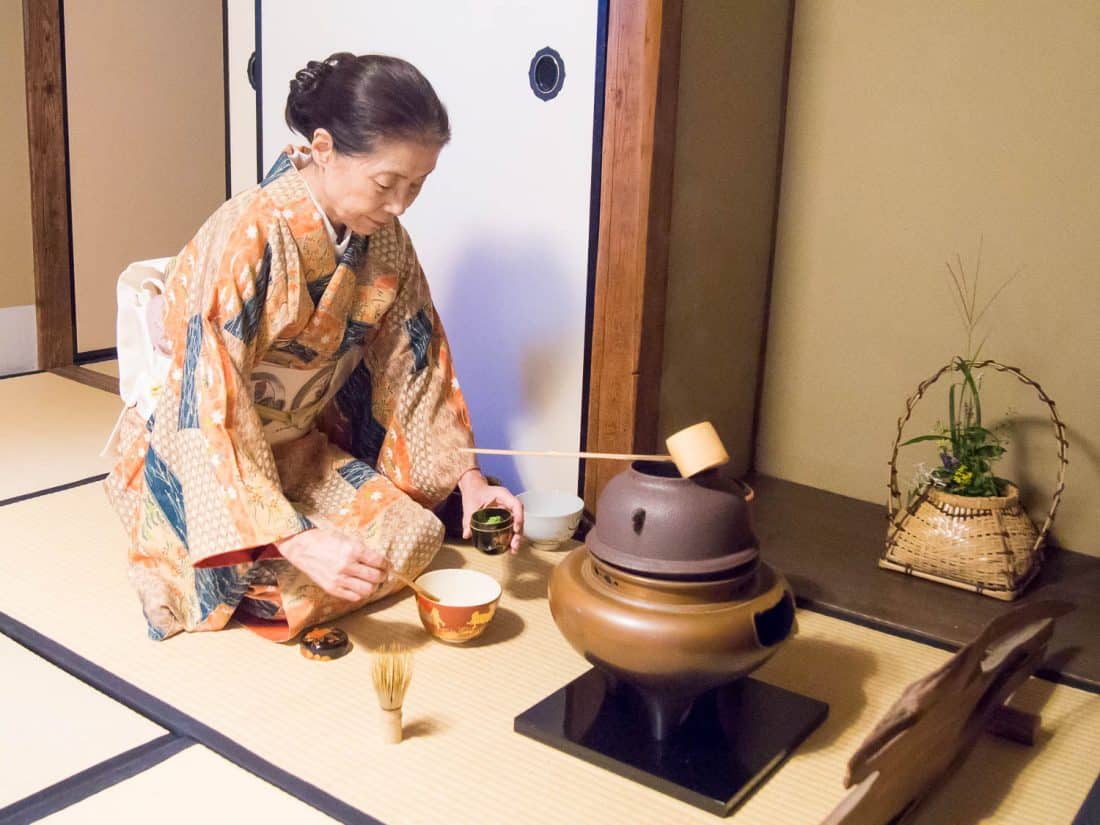
Tea isn’t just a drink in Japan and I highly recommend experiencing a traditional tea ceremony to learn more about this important part of Japanese culture.
You’ll learn the stages of the ritual, how to appreciate the tea bowl, and the concept of “ichi-go ichi-e” which means cherishing the moment, as it will never happen again.
Kyoto is the home of the tea ceremony. We did the Tea Ceremony Ju-An at Jotokuji Temple, which includes learning to whisk your own matcha. It was friendly and informative and groups are kept small.
We also participated in a tea ceremony at the gorgeous Gyokusen-en Gardens in Kanazawa, which is harder to book than the suggestion above.
Recommended Reading: Our 2 week Japan itinerary includes Kanazawa.
30) Drink Sake at an Izakaya
From the tranquillity of a tea room to the boisterousness of an izakaya, Japan is all about contrast.
An izakaya is a Japanese pub where you can drink sake (rice wine), beer and other alcoholic drinks accompanied by small tapas-like plates of food.
Note that smoking is allowed in some small bars in Japan. The legal drinking age is 20 years.
31) Eat Sushi
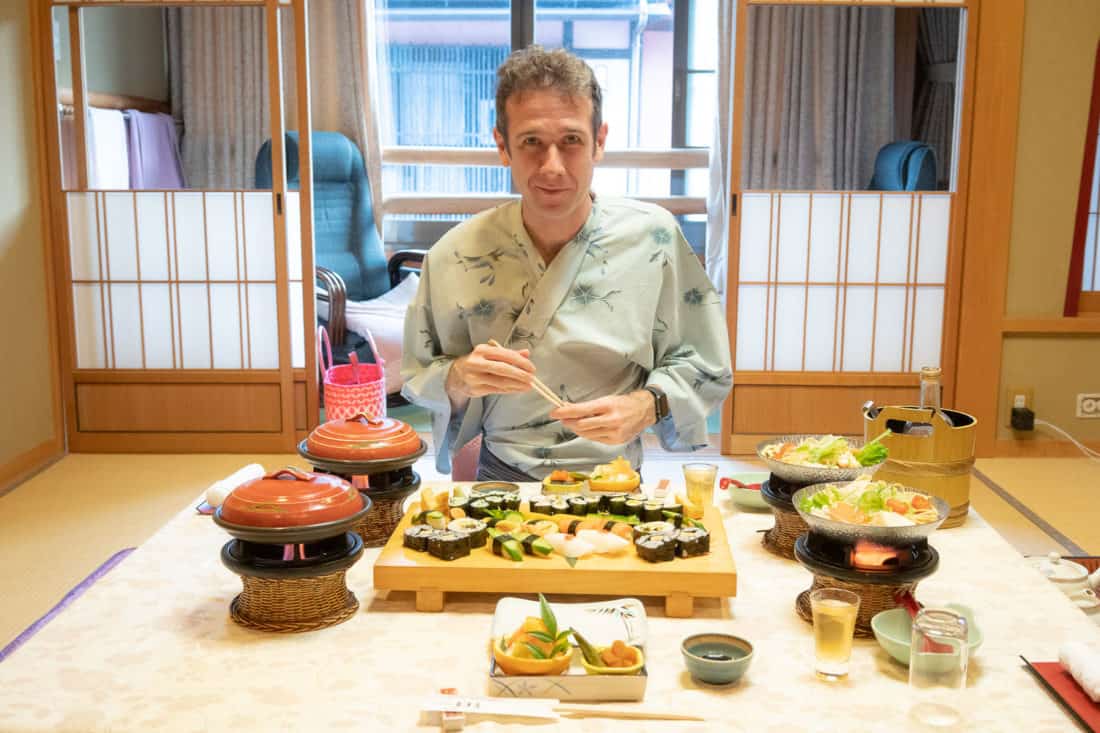
Sushi is Japan’s most famous dish so, of course, you’ll want to try it in its homeland. Eating sushi in Japan is different from elsewhere and there are strict rules—see this sushi in Japan guide for tips.
Sushi comes in many forms. While it all involves rice prepared with sushi vinegar, it doesn’t all include raw fish. Vegetarian sushi made with tofu, cucumber, or other vegetables is harder to find, but you can read our vegetarian Japan guide for ideas.
You can eat sushi everywhere from convenience stores to fine dining restaurants. The most famous (and exceedingly expensive) restaurant is Sukiyabashi Jiro in Tokyo—you can learn more about the revered chef in the documentary Jiro Dreams of Sushi.
It’s a difficult restaurant to get a reservation for. You must book through a hotel concierge service a few months in advance.
A more affordable option is Sukiyabashi Jiro Roppongi Hills, which is run by his son.
Another popular place to try sushi is the Tsukiji Fish Market.
32) Enjoy a Bento Box on a Train
A bento box is a Japanese lunchbox featuring a range of small dishes with a balance of flavours, textures, and food groups.
You can find them in train stations (where they are called ekiben and use local ingredients), convenience stores, and department store food halls.
This being Japan, they are works of art and very tasty. They are ideal for long train rides and picnics in the park.
A typical bento features rice, meat or fish, and pickled vegetables. Vegetarian bentos are not easy to find, but we did get one at Matsumoto in the Isetan department store near Shinjuku Station in Tokyo.
33) Hanami Under the Cherry Blossoms
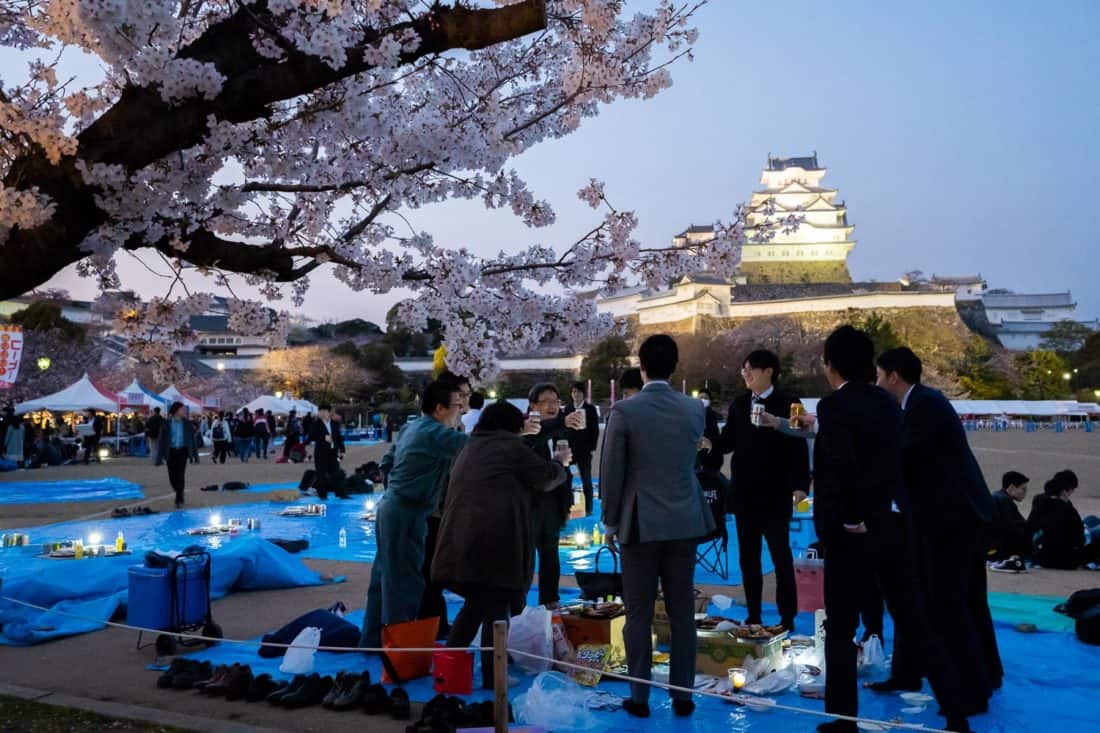
Hanami is a Japanese custom of viewing the transient sakura (cherry blossoms) that bloom for a few weeks in spring (usually late March to mid-April in Tokyo and Kyoto).
The most popular way to enjoy the blossoms is with a picnic under the trees. The Japanese gather in large groups with food and drinks for parties that often last all day and into the night.
To enjoy your own hanami, you can pick up a bento box from a department store or there are many picnic options in convenience stores as well as beers and sake. Look out for sakura-themed items like mochi, kitkats, and even beer.
Our favourite hanami spots were Handayama Botanical Garden in Okayama and Shinjuku Gyoen National Garden in Tokyo where we enjoyed three picnics in a week under the late-blooming cherry trees.
34) Order Hot Coffee or Soup from a Vending Machine
In Japan you’ll find vending machines everywhere—in train stations, on almost every street corner, and even on hiking paths. They are very convenient as you’ll never go thirsty.
Most vending machines sell drinks—cold green tea, milk tea, soft drinks, energy drinks, juice (some with jelly chunks), and water.
It’s not just cold drinks, though—in the colder months you can buy a can of hot coffee, tea, and even corn soup to go!
You can tell they are hot as they’ll have a red label (rather than blue for cold drinks). You can also find vending machines that sell alcohol.
It may not be the best coffee in the world, but Simon loved the convenience of being able to pick up a can of hot coffee anywhere, especially on cold mornings when we had a train to catch.
His favourite was Tully’s—he found the more common Boss coffee (randomly advertised by Tommy Lee Jones) less appealing.
Spiritual Things to Do in Japan
Visiting a Buddhist temple or Shinto shrine is a must do in Japan even if you aren’t religious (we’re not).
They are diverse, beautiful, peaceful (sometimes), and fascinating with many rituals to observe. They are often set amongst lovely natural settings in forests or on mountainsides.
The best places to visit temples and shrines are Kyoto (Japan’s capital for 1000 years until 1868) and Nikko (a UNESCO World Heritage Site a few hours north of Tokyo), but you can find them all over the country even in modern Tokyo and Osaka.
Read our Kyoto temples guide for more on the differences between temples and shrines.
35) Stay in a Temple at Koya-San
One of the most unusual things to do in Japan is to spend the night in a temple in the sacred mountain town Koya-san, about 90 minutes from Osaka.
Many temples offer shukubo or temple lodging where you can sleep in tatami mat rooms, soak in communal onsen baths, and enjoy delicious shojin ryori vegetarian Buddhist meals.
Early in the morning, you can join the monks for their chanting and fire ceremony.
We stayed in the cheapest temple accommodation, Haryo-in, but it’s quite basic and not available to book online. Next time I’d pay more for one of the more traditional temples like 1000-year-old Eko-in.
36) Hike Through Torii Gates at Fushimi Inari
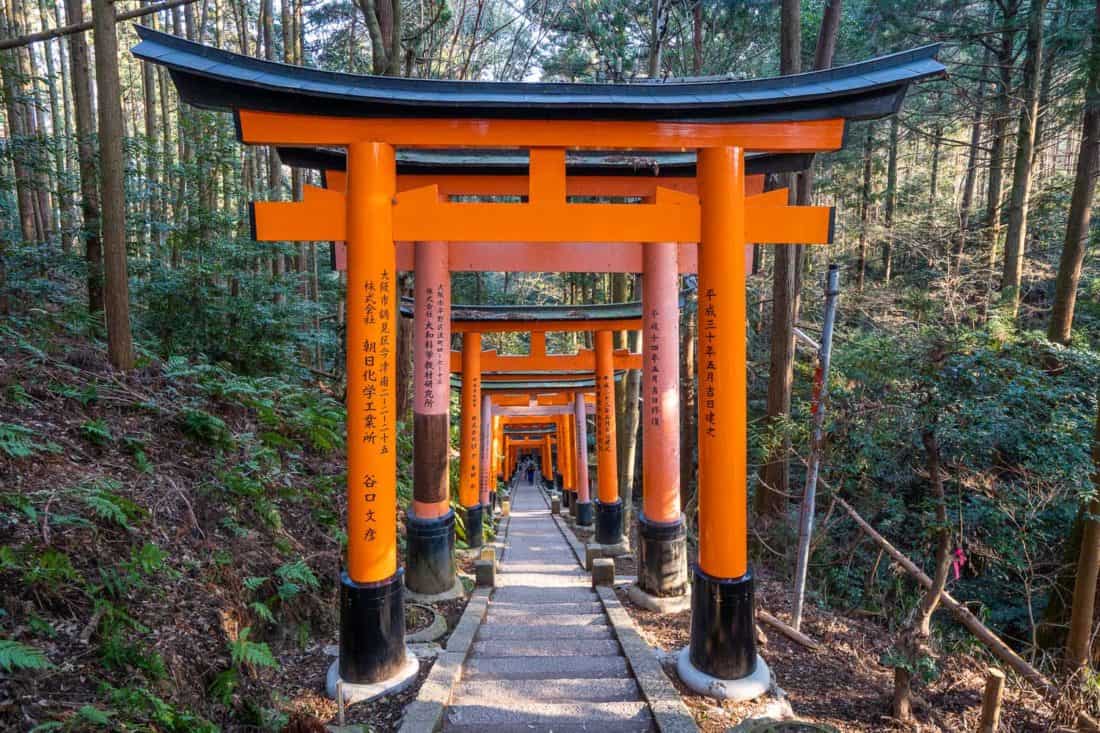
My favourite shrine in Japan and one of the most popular things to do in Kyoto is the unique Fushimi Inari.
Thousands of bright orange torii gates snake up through a forest on the side of a mountain and it takes about 90 minutes to complete the full circuit (which I recommend as it’s much quieter at the top).
Fushimi Inari is one of the top tourist attractions in Japan and gets incredibly busy, so I highly recommend arriving before 7 am or after 8 pm to avoid the worst of the crowds.
Although I prefer it early in the morning, hiking it at night feels more adventurous with a slightly spooky atmosphere (watch out for wild boars!). The shrine is free and open 24 hours.
37) Visit the Golden Temple
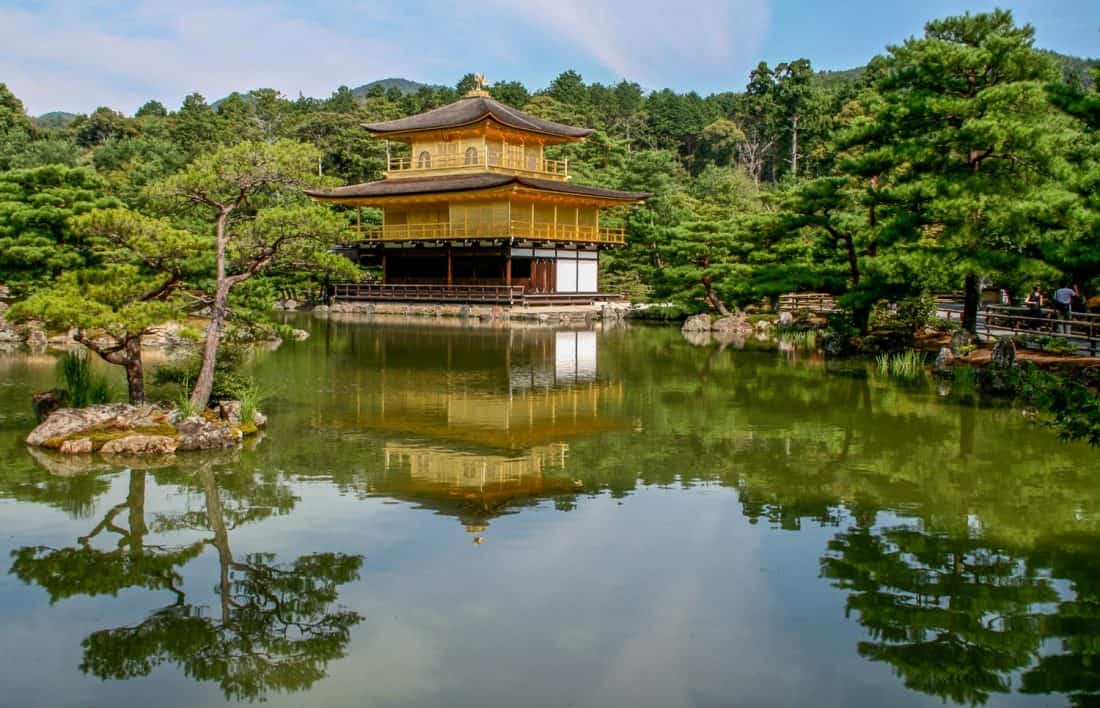
Another Kyoto highlight is Kinkaku-ji or the Golden Temple.
We expected it to be overrated (and it is very crowded), but the shimmering gold pavilion reflected in a pond amongst leafy gardens lived up to the hype.
38) Get Your Fortune Told at a Temple or Shrine
Omikuji are fortune-telling paper strips that can be bought at Japanese temples and shrines.
The fortunes range from great good luck to great bad luck (luckily the worst we’ve got is “pretty good”). Some of the more popular temples like the Golden Temple in Kyoto have fortunes in English.
If you get a bad fortune, make sure you leave it at the temple to avert the bad luck—there are dedicated areas to tie them. If it’s a good fortune, you should carry it with you.
39) Meditate at a Zen Garden
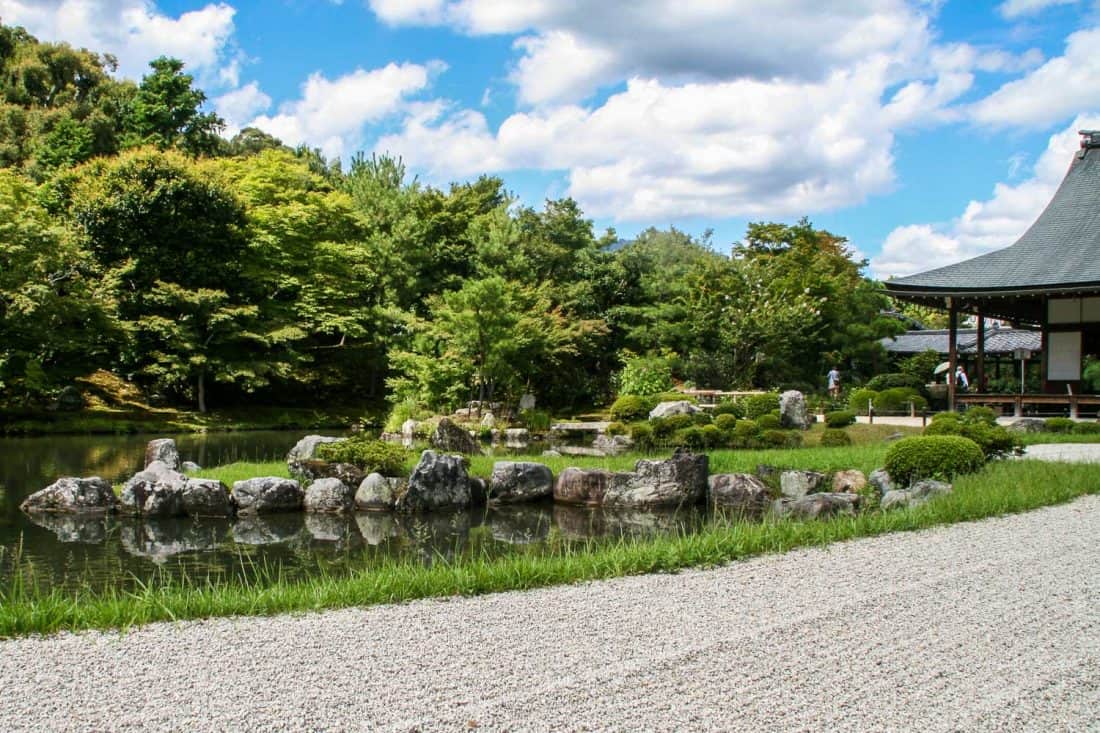
Zen Buddhist temples usually feature kare-sansui or dry landscape gardens made from rocks and gravel carefully raked into patterns that suggest rippling water. They are simple, elegant, and the perfect place to meditate.
Kyoto is the best place to find Zen temples. Ryoan-ji Temple is the most famous (and crowded), and we enjoyed the gardens at Kennin-ji and Kodai-ji (especially when the cherry tree is in bloom).
At Entoku-in we had the chance to create our own miniature garden.
40) Visit a Temple at Night
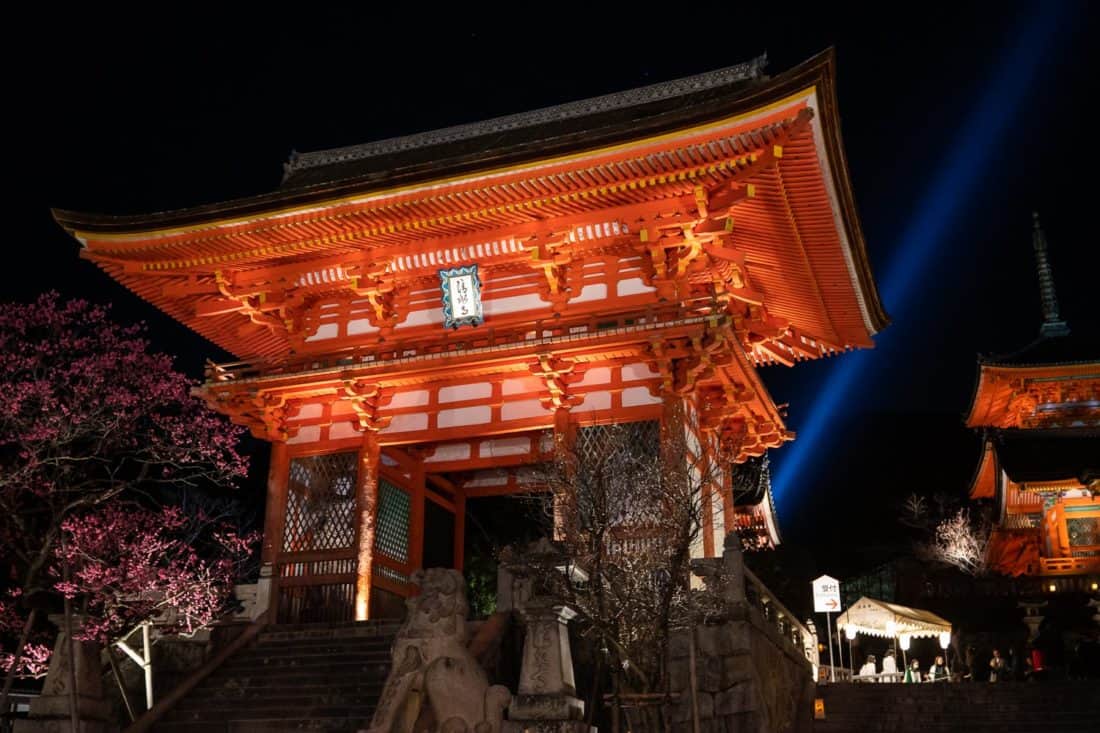
In the spring cherry blossom and autumn leaf seasons some temples open at night.
They are beautifully illuminated, sometimes feature special light shows, and it feels like a different experience visiting in the dark.
We especially enjoyed night visits to Kiyomizu-dera and Kodai-ji in Kyoto.
41) See the Giant Buddha at Nara
Nara is a wonderful day trip from Kyoto. It was Japan’s first permanent capital and is full of historic treasures including many UNESCO world heritage sites.
The highlight is the immense Daibutsu-den (Hall of the Great Buddha) at Todaiji. It’s the largest wooden building in the world and houses the 15-metre tall gold and bronze statue of Buddha that dates back to 751.
Nearby Kasuga Taisha Shrine is also well worth visiting with its many buildings on a wooded hillside. Look out for the thousands of deer in Nara Park.
42) Explore the Temples at Nikko
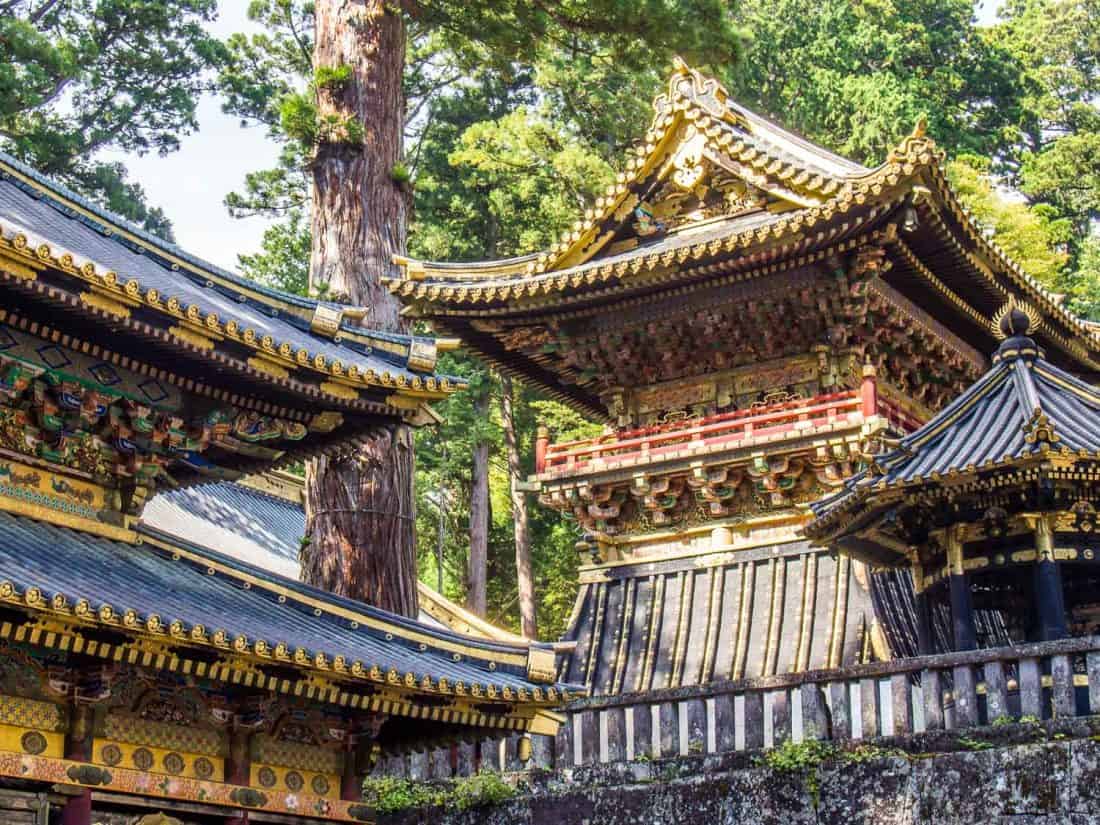
Temple fans shouldn’t miss Nikko, a mountain town full of UNESCO World Heritage temples a few hours north of Tokyo.
Many people visit on a day trip, but it’s worth staying overnight to get an early start and avoid the crowds.
Toshogu Shrine is the main attraction and features more than a dozen lavishly decorated red and gold buildings amongst huge, ancient cedar trees.
I also recommend playing games at atmospheric Futarasan-jinja and hiking up the mountain to the tranquil Takino shrine.
43) Get Off the Beaten Track at Otagi Nenbutsuji
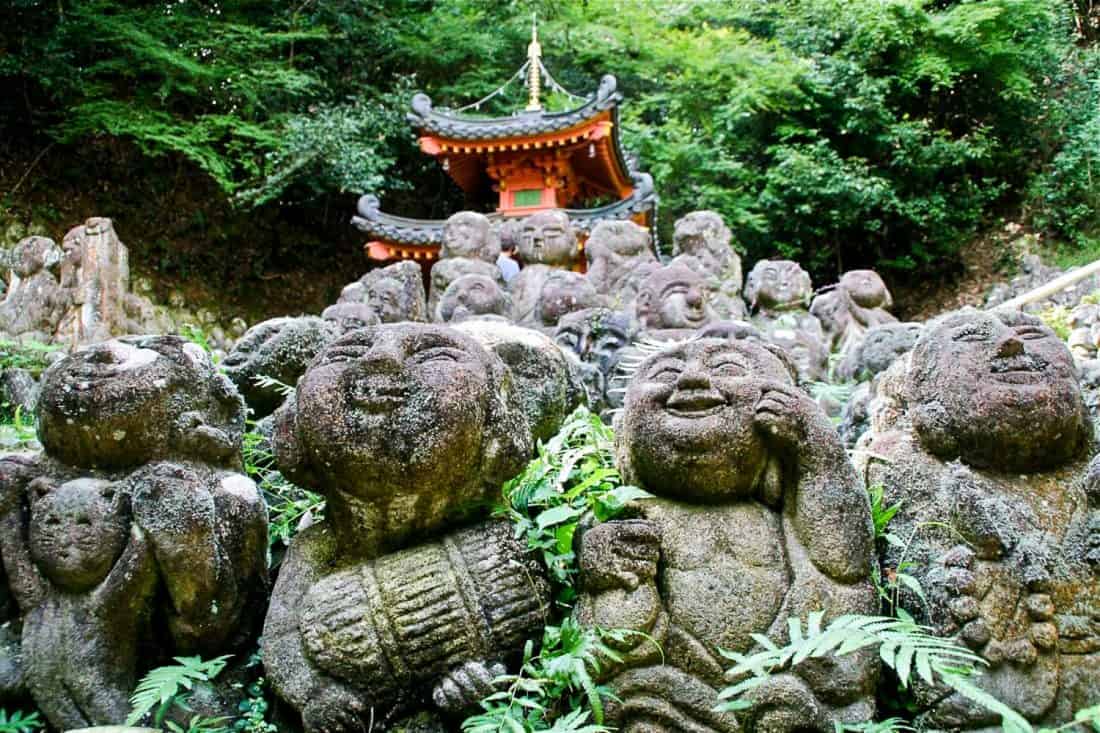
One of my favourite temples in Kyoto is the quirky Otagi Nenbutsuji in the lovely Arashiyama neighbourhood.
It’s much quieter than other temples in the area, and the shady temple complex features 1200 stone sculptures of the Buddha’s disciples all with different facial expressions and poses from scary to serene.
44) Stay Overnight on Miyajima Island
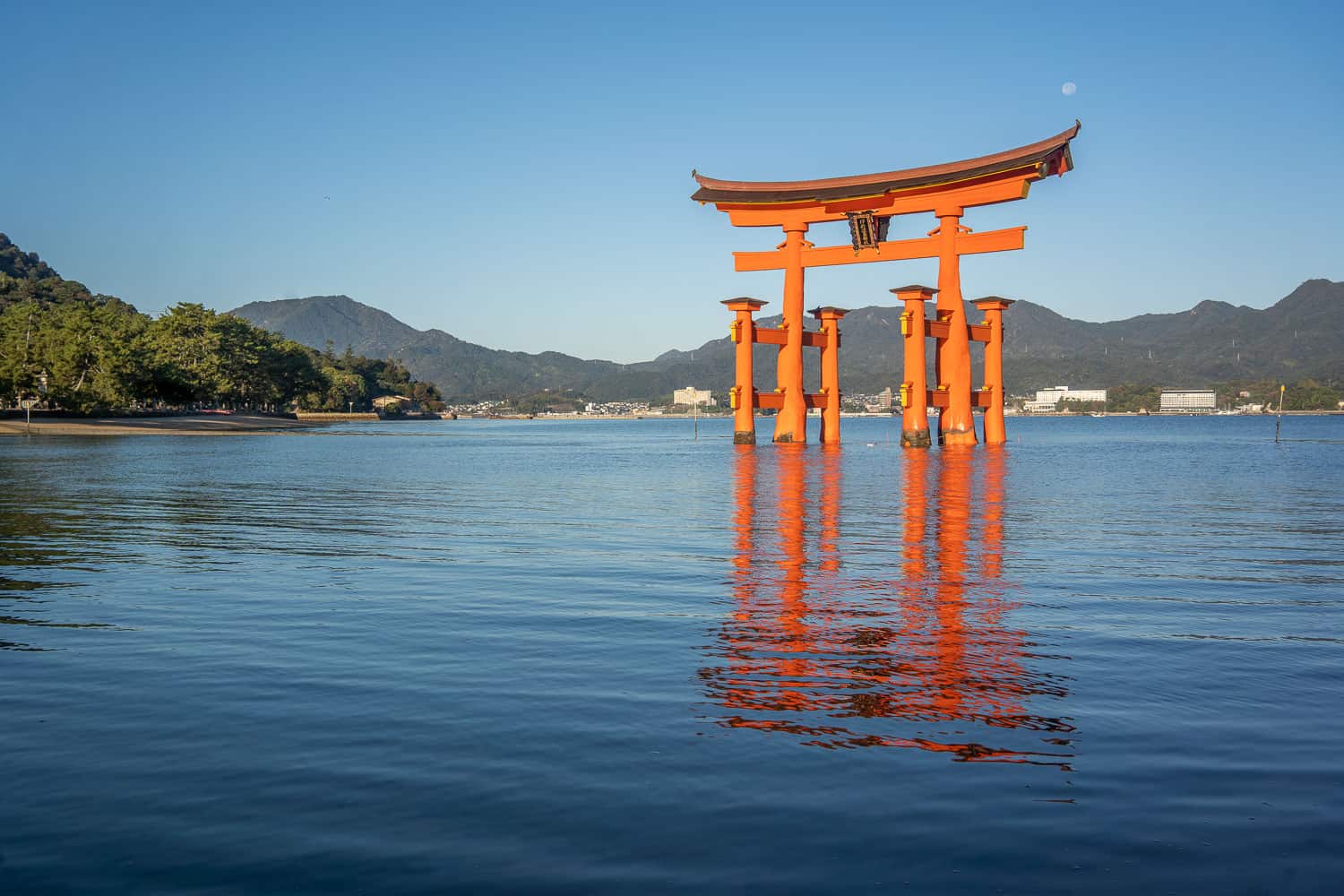
Miyajima Island is known for the famous torii gate at Itsukushima Shrine that seems to float in the sea at high tide.
The island is easy to combine with Hiroshima and offers a taste of Japan’s natural beauty—forest temples, roaming deer, and stunning sea views from Mt Misen, reached by cable car or strenuous hike.
Miyajima does attract large crowds, though, so the best way to appreciate its charm is to stay overnight and enjoy the tranquillity once the day trippers have left.
Iwaso Ryokan offers a traditional inn experience in the perfect location just a short walk from the sights. Our multi-course dinner was excellent, and we loved tottering down to the torii gate at night in the provided yukata and geta.
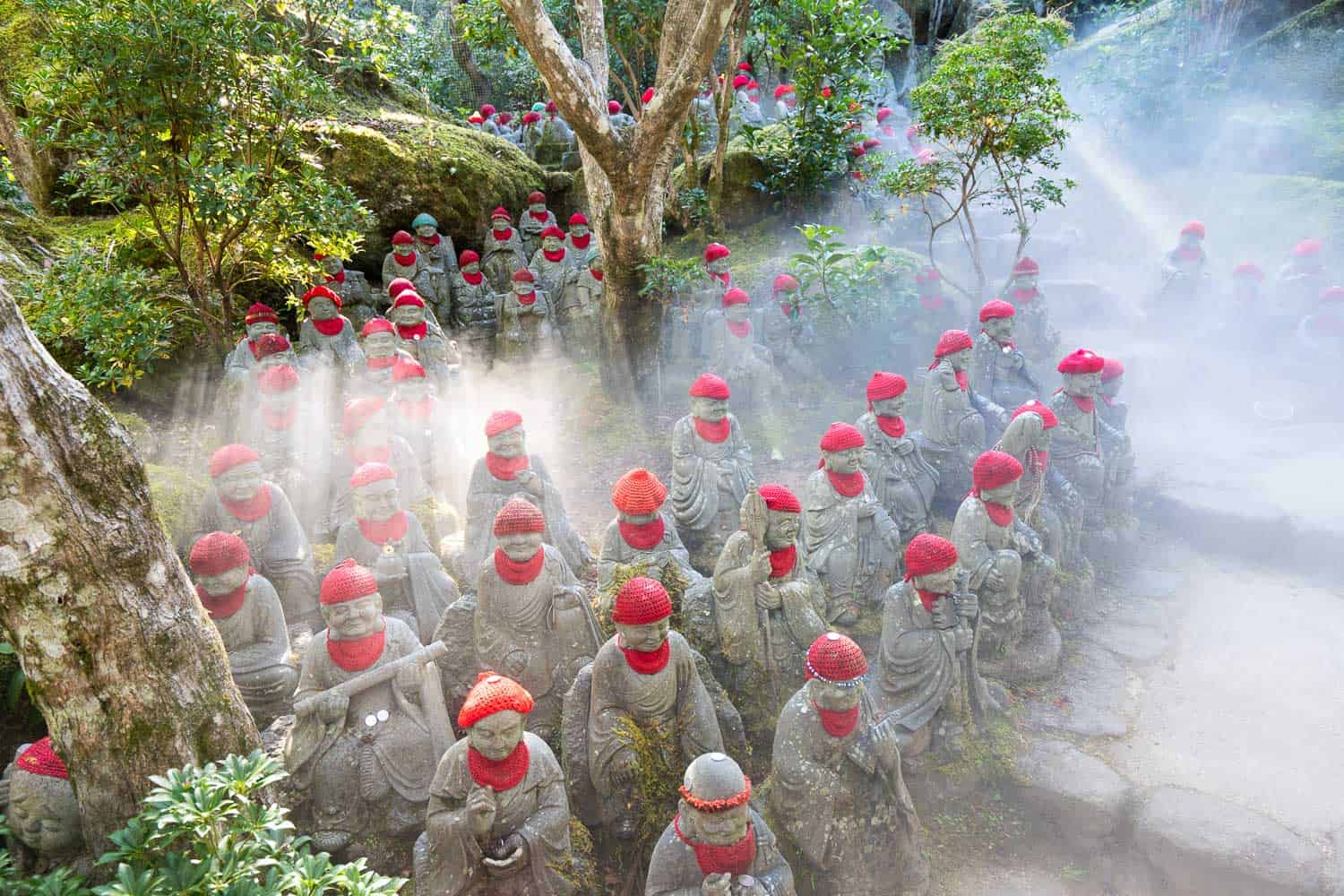
Best Beautiful Japan Attractions
There’s so much more to Japan than the cities. You’ll find many gorgeous mountains, lakes, islands, waterfalls, rivers, rice fields, and forests.
Temples and shrines are also often in beautiful natural settings, so see the section above as well.
Here are just some of the top things to do in Japan in nature. There are many other options to experience Japan on foot, bike, boat, and skis.
45) Attempt to See Mount Fuji
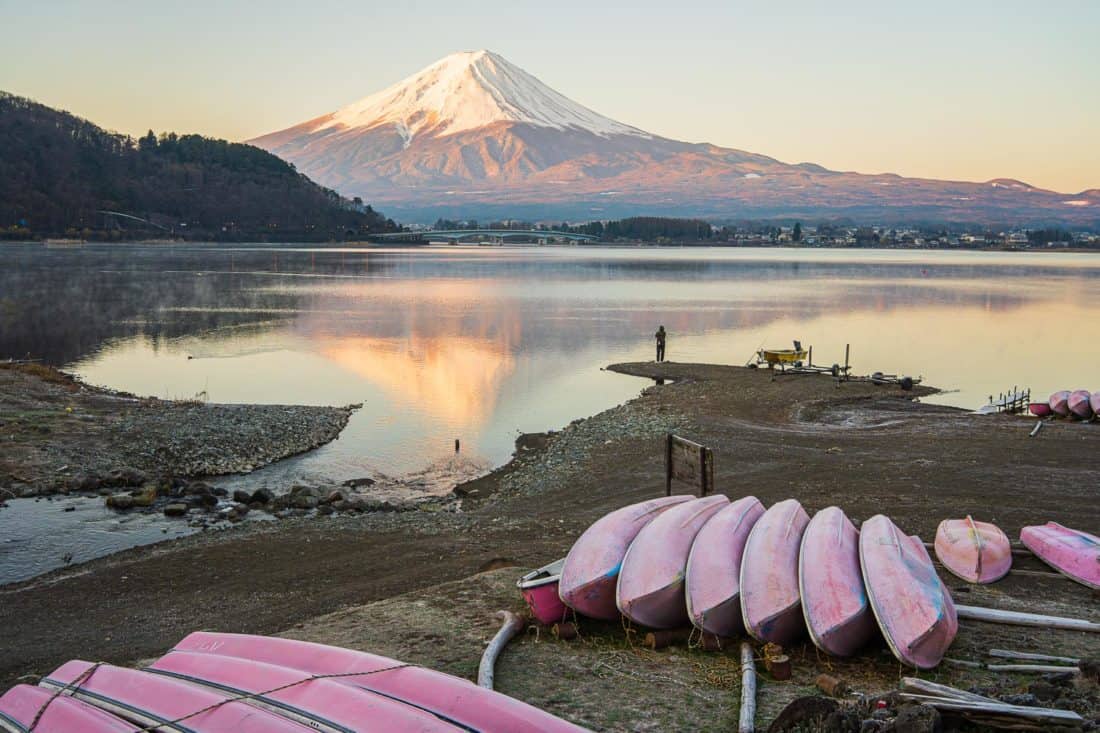
For many people the iconic Mount Fuji is a top Japan sightseeing spot. The perfectly shaped volcano is Japan’s highest mountain at 3776 metres, and it’s especially lovely in the winter and spring when it is snow-capped.
The best towns to see Mount Fuji from are the hot spring resort Hakone or the Fuji Five Lakes area (especially the lakeside town Kawaguchiko). We’ve enjoyed visits to both, but the view is better at Kawaguchiko as it’s closer.
Mount Fuji is elusive, though, and is often obscured by clouds. It’s best to allow a few days in the area to increase your chances of seeing the peak.
You can also climb Mount Fuji but only in July and August and it’s a challenging climb.
Read our guide to visiting Lake Kawaguchi for the best places to see Mount Fuji and other tips.
46) Loop Around Hakone
While Hakone is a great place to see Mount Fuji, it also has a lot to offer when the mountain is hiding behind clouds.
With the Hakone Freepass you get unlimited rides on transport in the area and can follow a fun loop which includes a pirate ship cruise across Lake Ashi, ropeway (cable car) up a mountain to Owakudani, an active volcanic valley, and a train through the mountains.
Hakone is the perfect spot to stay in a ryokan with onsen. We liked staying by Lake Ashi for more chances to see Mt Fuji. Our Japan 2 week itinerary has some suggestions.
47) Go Cherry Blossom Viewing
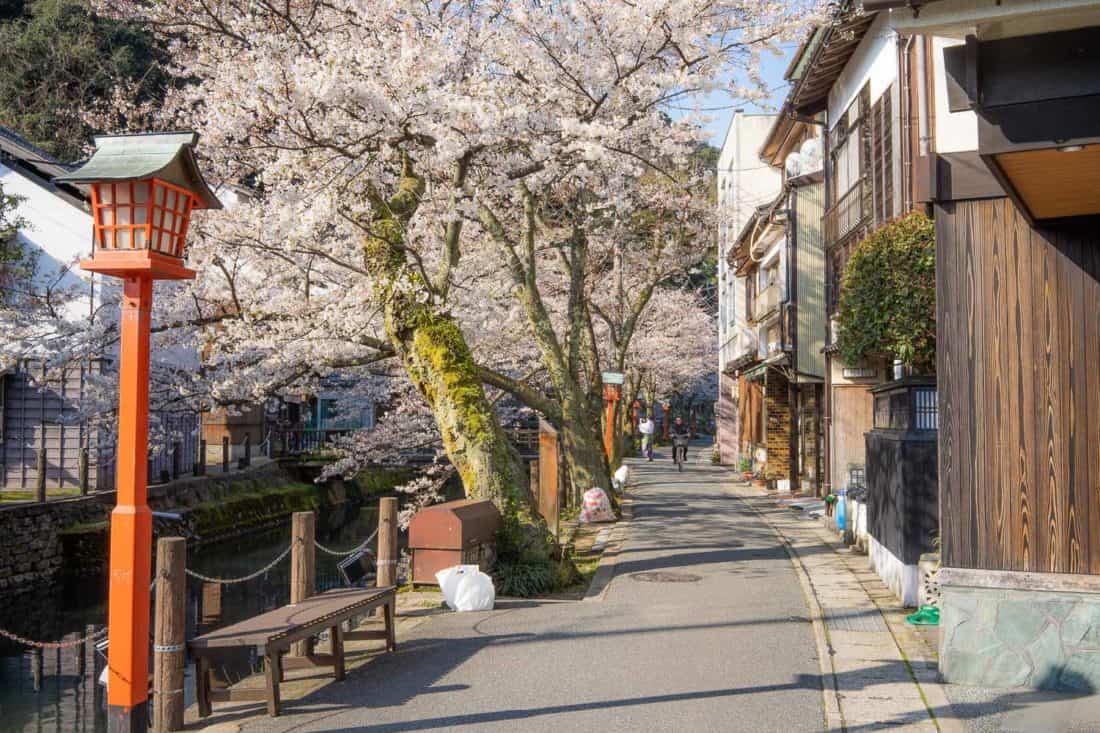
Japan in spring lives up to the hype. The fleeting sakura (cherry blossoms) are truly spectacular, and they are everywhere, not just limited to a certain park or canal.
It’s a joyous time of year when locals hit the parks for hanami picnics and eat cherry-blossom-themed food.
Kyoto and Tokyo are excellent famous cherry blossom spots, but we also enjoyed Okayama where it wasn’t as crowded.
Early April is usually the peak sakura season, but it is never guaranteed.
See our guide to the best cherry blossom spots in Kyoto.
48) Enjoy the Stunning Autumn Colours
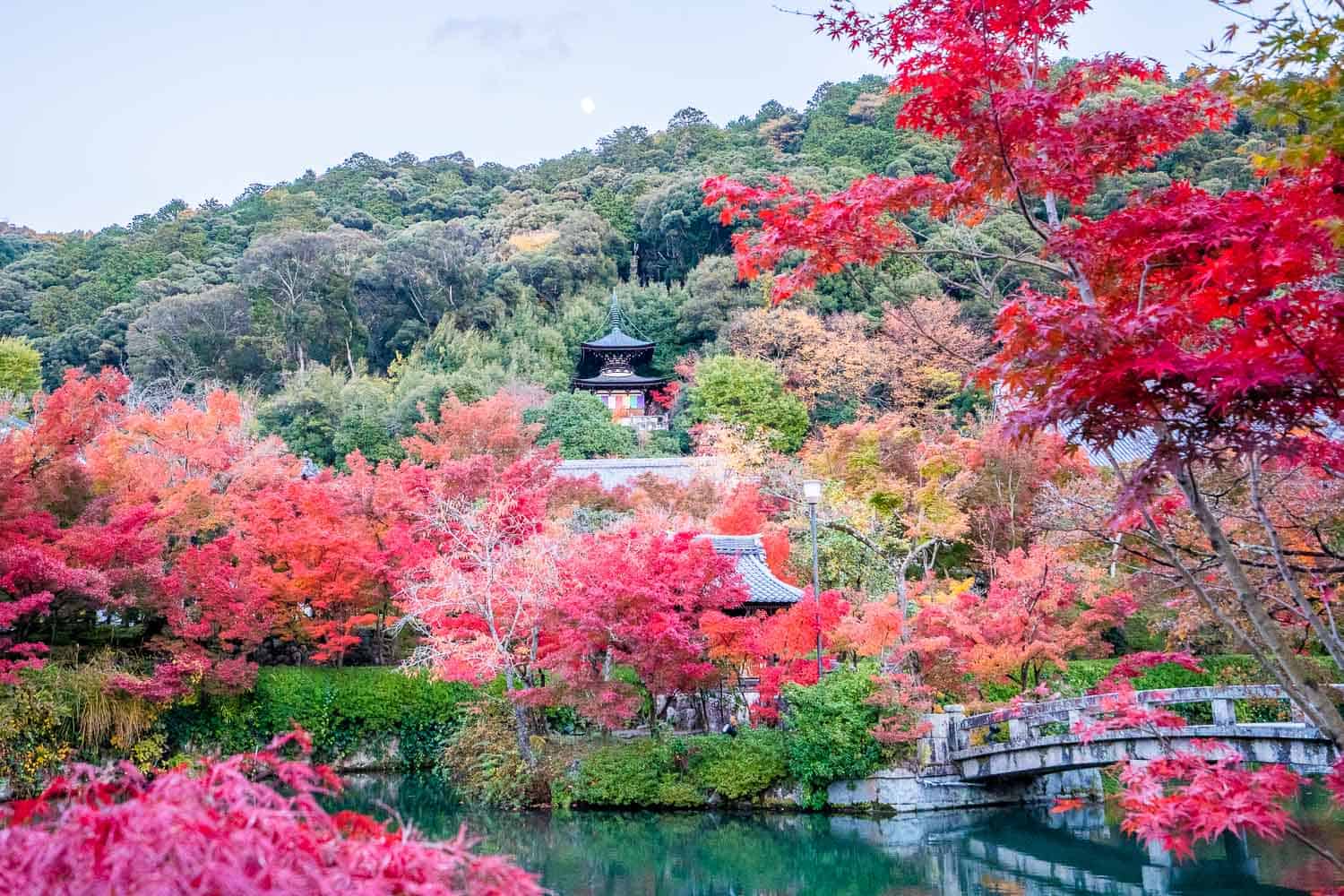
While not quite as iconic as spring, autumn in Japan is just as stunning.
In temples and parks, maple trees turn shades of yellow, orange, and scarlet, creating an amazingly colourful scene.
While momiji (red leaves) can be found all over the country, Kyoto is one of the best spots. Our favourite temples in autumn were Eikando, Enkoji, and Jojakkoji, but there are so many options. See our guide to where to see autumn foliage in Kyoto.
Autumn colours usually peak in Kyoto and Tokyo in late November. If you are visiting Japan earlier, head to higher elevations or travel further north (in Hokkaido the peak is early October).
49) Cycle the Countryside
A fantastic way to experience rural Japan is by bike. We really enjoyed a group cycling tour with Satoyama Experience from the adorable town of Hida-Furukawa near Takayama.
We learnt about local traditions and cycled past rice fields, rivers, mountains, and idyllic villages.
We also did a DIY half-day trip along the Kibiji Bike Path past beautiful off-the-beaten-path temples, rice fields, and cherry blossoms.
From Okayama take the train to Bizen-Ichinomiya where you can hire a bike one-way to Soja then hop on the train back from there.
See my post on things to do in Okayama, Japan for more details on the Kibiji Bike Trail.
50) Ride Over the Bridges of the Shimanami Kaido Bike Path
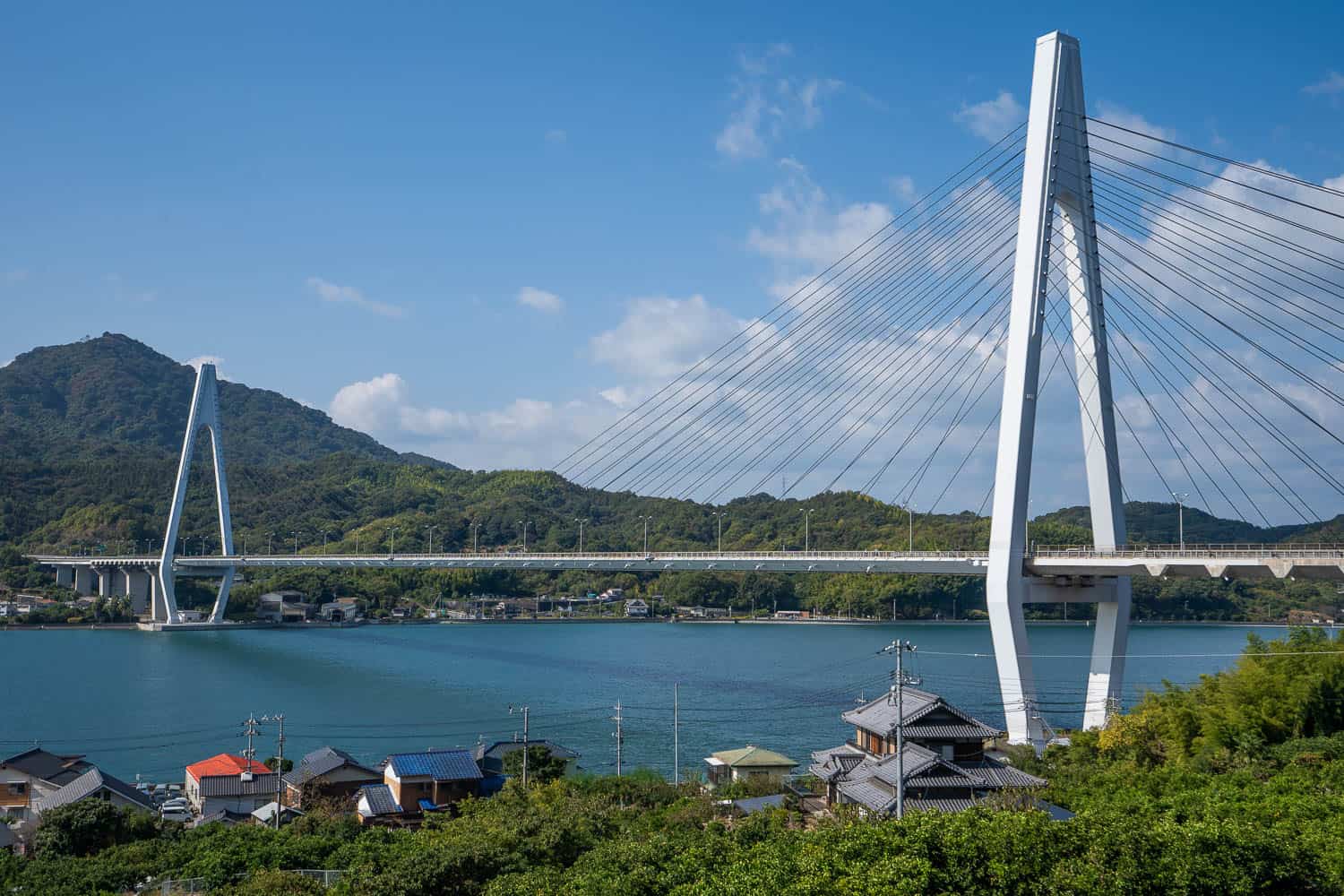
One of our favourite off-the-beaten-track activities in Japan was cycling the Shimanami Kaido, a road and bike trail that crosses six small islands in the Seto Inland Sea.
It starts from Onomichi, a charming seaside town an hour east of Hiroshima, and ends 70km later on the island of Shikoku.
Some people cycle the whole thing in one or two days, perhaps staying overnight on one of the islands. We did a day trip from Onomichi instead, cycling 30km to Setoda and taking the ferry back.
Onomichi is well worth a day as well (don’t miss Pour, Simon’s favourite coffee shop in Japan).
51) Walk Through a Bamboo Forest (But Not in Arashiyama)
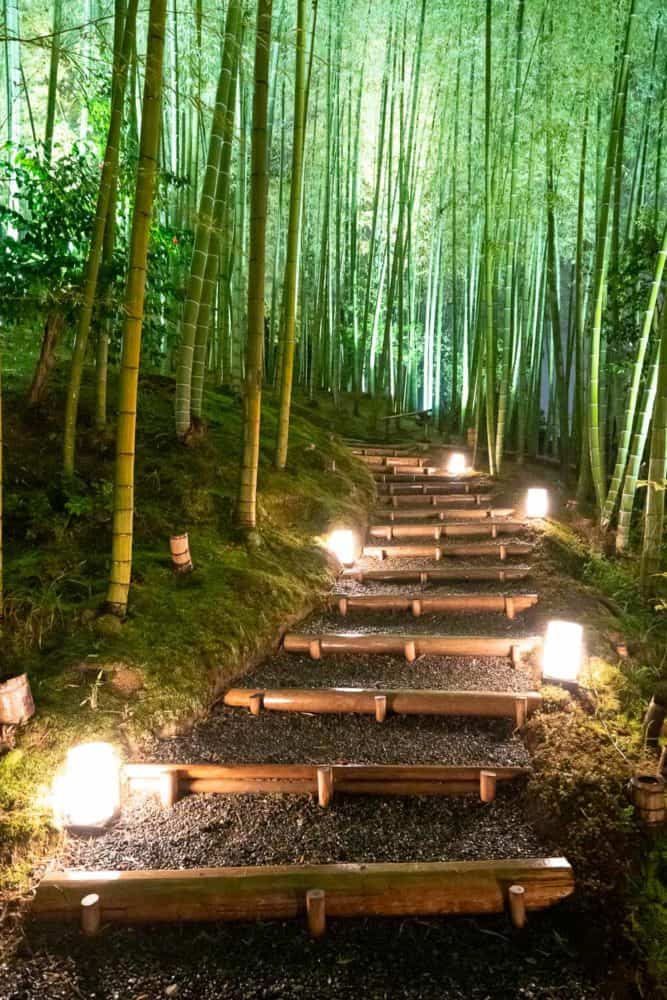
There’s something magical and very Japanese about a bamboo forest with its towering green stalks swaying in the breeze.
By far the most popular bamboo forest in Japan is in Arashiyama in Kyoto, which is considered one of the best things to see in Japan.
Honestly, it’s so crowded that I much prefer the smaller bamboo groves that you find in temples such as Jizo-in, Kodai-ji, and Jojakko-ji. I encourage you to seek out a more peaceful bamboo forest for yourself.
52) Visit the Art Island of Naoshima

Naoshima is a rural island in the Seto Inland Sea that has been transformed into a hub of contemporary art. We visited as a day trip from Okayama and hired e-bikes to cycle the island (it’s not very big).
As well as enjoying beautiful coastal views we saw Yayoi Kusama’s famous yellow and red pumpkins and visited several art museums and the unique Art House Project with installations spread over abandoned houses.
See our Naoshima Island itinerary for everything you need to know for a wonderful day here.
53) Stroll a Japanese Garden
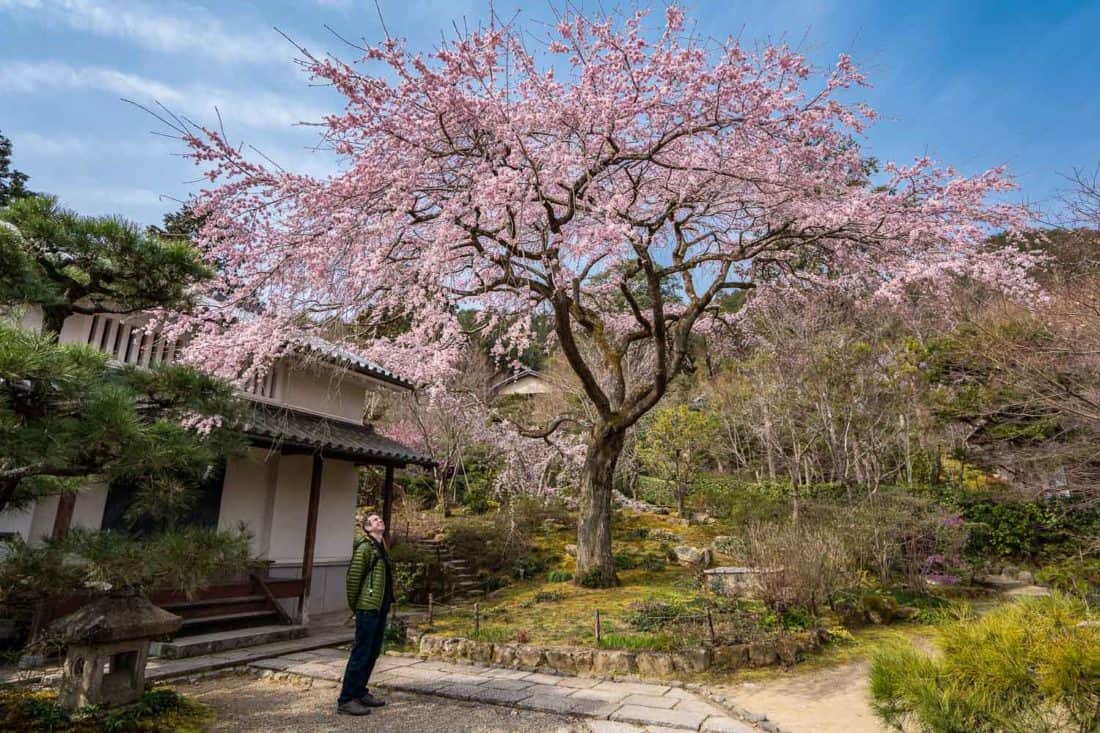
You can’t visit Japan and not take a stroll through a traditional garden. There are many styles of Japanese gardens and they all highlight the beauty of nature and avoid artificial components where possible.
Classic elements include moss-covered rocks, carp-filled ponds, stone lanterns, wooden teahouses, maple trees, and cherry blossoms. Many are found at temples.
There are so many to choose from, but some of my favourites are the tiny but exquisite Gyokusen-en Gardens in Kanazawa, Shinjuku Gyoen in Tokyo, and the grounds of Jojakko-ji Temple in Arashiyama, Kyoto.
The moss garden at Saihoji Temple in Kyoto is also exceptional and worth the higher price (book two months in advance). See my guide to Saihoji the Kyoto Moss Temple for details.
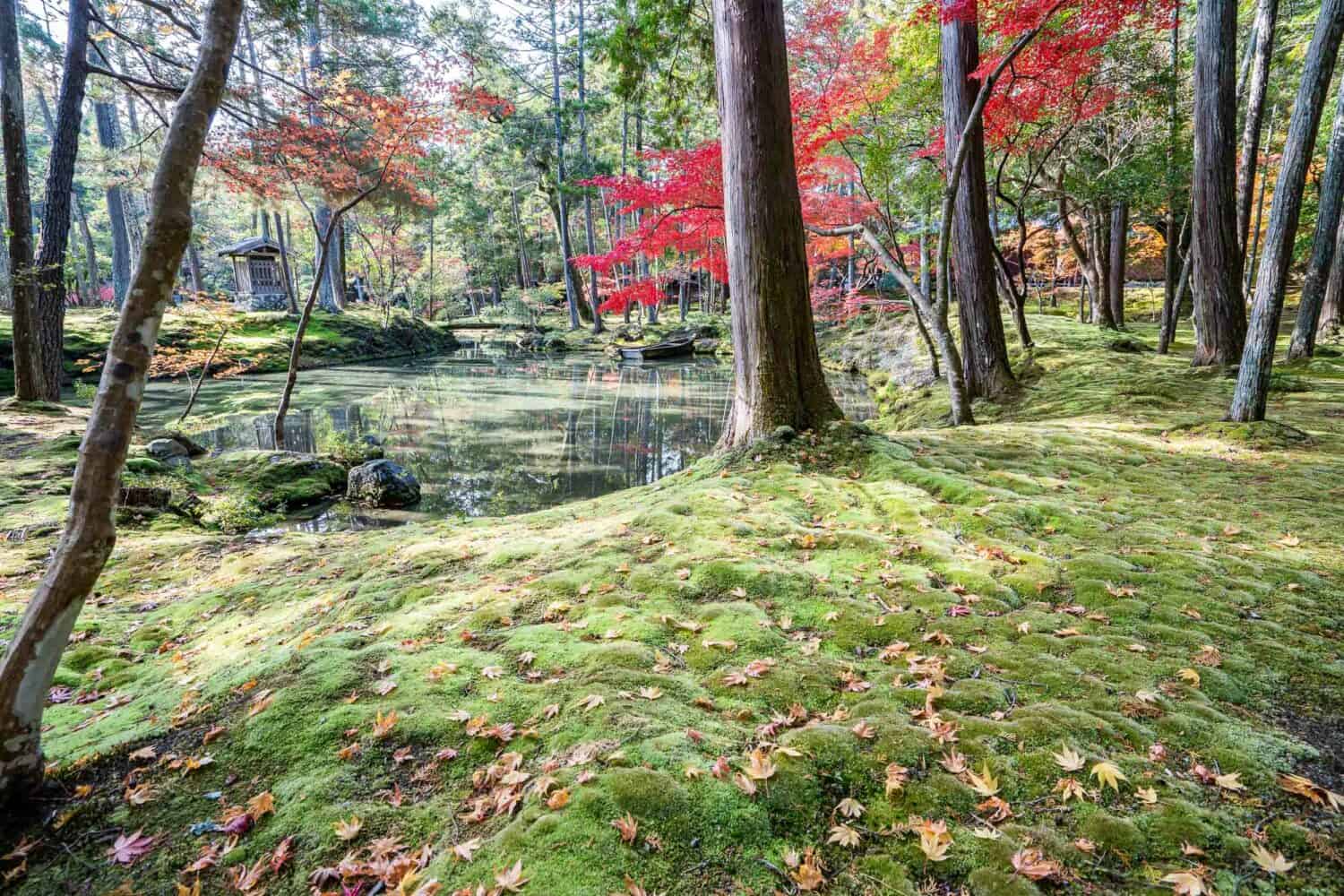
54) Hike the Historic Nakasendo Trail
The Nakasendo Trail connected Tokyo and Kyoto during the Edo period. Along the journey through the mountains there were many “post towns” where lords and samurai could stop to rest at traditional inns and soak in hot springs.
You can still do a half-day hike on the most scenic part of the trail from Tsumago to Magome (5 miles/ 3 hours).
A typhoon prevented us from doing the walk, but we still enjoyed our stay in the picture-perfect traditional Japanese village of Tsumago, which is well-preserved with many wooden buildings.
55) See Traditional Thatched Houses at Hida Folk Village
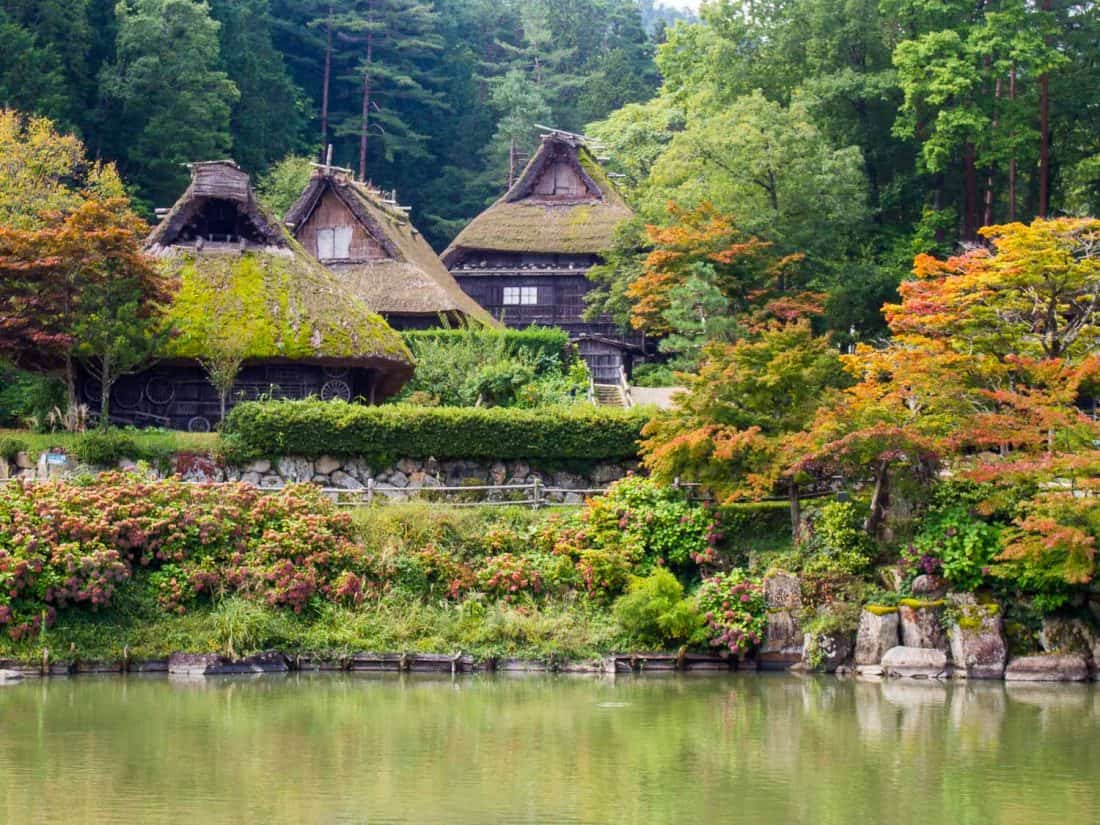
We thought the Hida Folk Village near Takayama would be too touristy, but the open-air museum is a beautiful place, especially in the autumn.
It features traditional thatched houses from across the Hida region that were moved to the museum in 1971. It was fascinating to see what life was like for rural Japanese in the Edo period.
Another option if you have more time is to stay in one of the Gassho-style thatched houses in the village of Shirakawa-go (50 minutes by bus from Takayama).
56) Walk from Kibune to Kurama
A worthwhile half-day trip from Kyoto is to take a 30-minute train ride to the village of Kibune in the Kitayama Mountains. From there you can walk through the forest over the mountain to Kurama-dera, a temple with fantastic views.
Continue to the village of Kurama where you can have a tasty vegetarian lunch at Yoshuji or soak in an onsen before hopping on the train back to Kyoto. The 5km (3 mile) hike took us two hours.
Or in the summer you can hike it in the opposite direction and finish with a meal on a platform over the river in Kibune.
It’s an easy, peaceful, and beautiful escape from the city.
Planning Your Japan Itinerary
See our post on the best places to visit in Japan for our top recommendations.
Kyoto and Tokyo are the most popular destinations for first-time visitors and are a good combination for seeing the traditional and modern sides of the country.
I also recommend spending at least one night (more if you have time) in more rural locations such as Hakone (for Mount Fuji), Takayama (for traditional wooden houses), Nikko (for temples), or Koya-san (for an overnight temple stay).
Here’s our recommended Japan 2 week itinerary.
Japan Travel Tips
See our other Japan blog posts for more tips:
- Planning a Trip to Japan: Dos and Don’ts
- 31 Unforgettable Things to Do in Kyoto
- 26 Cool Things to Do in Tokyo
- Is a Japan Rail Pass Worth it?
- Where to Stay in Japan: A Guide to Accommodation Options
- 20 Fascinating Books to Read Before Visiting Japan
- Vegetarian Survival Guide to Japan
I hope this post has given you plenty of ideas for what to do in Japan. Enjoy exploring this weird and wonderful country!
If you enjoyed this post, pin it!
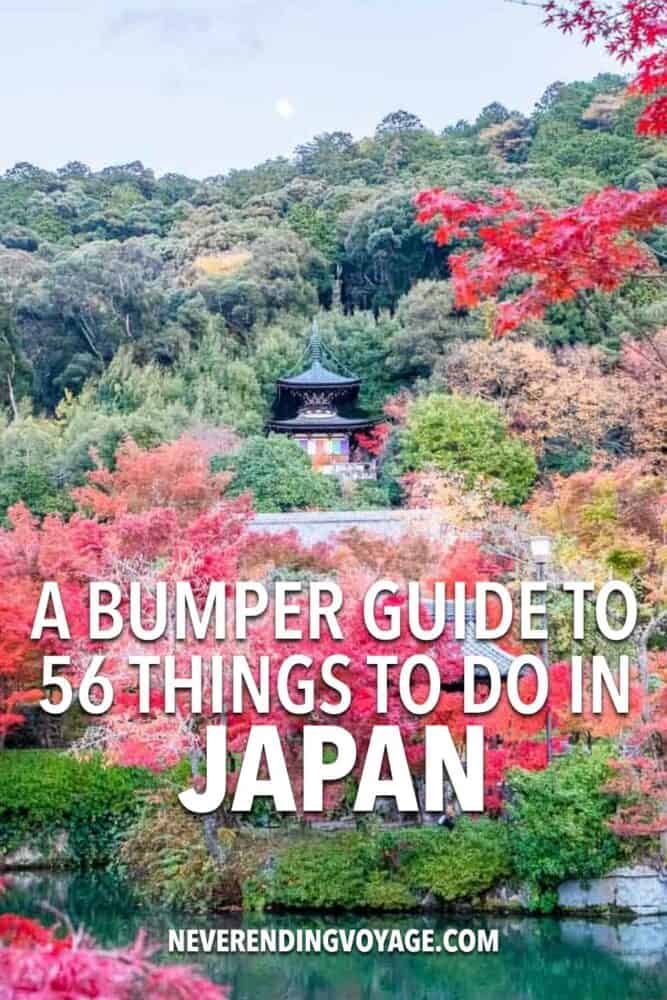
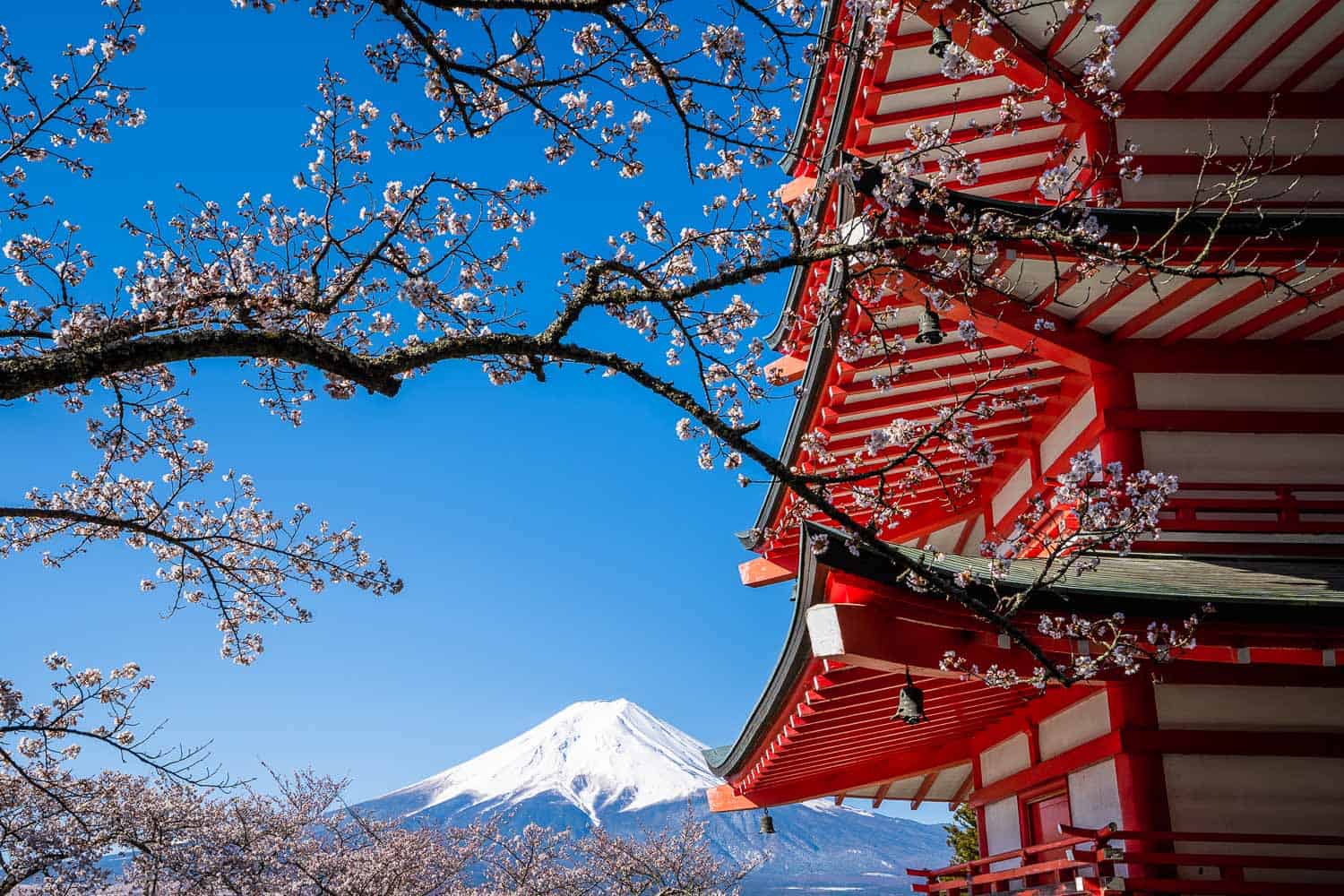
Hi Erin, Just wanted to thank you for putting this blog so neatly and simple to follow AND including everything that has to be experienced while in Japan in one plater.
Definitely will be referring to your blog while we plan our June trip this year.
Any advise or tips for traveling with a one year old?! :)
Thank you for sharing your experience.
Geita :)
Thanks for your kind words, Geita! We have no experience travelling with kids, but our friends enjoyed Japan with their toddler. Enjoy!
I so happy to have stumbled upon your site.
We are only just beginning to plan our Japanese trip and your insights have given us a terrific starting point.
Thank you for sharing your experiences and knowledge.
Thanks Tiffany and good luck planning your trip!
Lots of great information in here, thank you for all the tips! I can’t wait to go back and see more of Japan :)
Such a wonderful blog. Thank you for all the tips. What time is best to visit Japan in your opinion? Flight tickets are pricey around the cherry blossom time late March early April.
I don’t think there’s a bad time to visit Japan, but if you want a quieter/cheaper time without the summer heat/winter cold, I’d go for mid/late May or September/October.
Thank you.That information help me.😃
So much of nice and valuable info… keeping things short and sweet is how I like🙂
Thank you Erin!
Always wanted to go to Japan. Thank you for this post is will help in my school poster homework! 🇯🇵
Ok this is amazing things about this tower thing i forgot the name so i just love it cause. because how the tower and the color my favorite color is white ___________________________________________.
Very insightful and helpful. Thank you :)
I want to genuinely thank you for sharing your experience and trips. as they have been incredibly helpful in planning my own 25 day trip in January. I will be visiting around ten or more of the locations you’ve shared and a dozen of the activities you listed. I do have one question i was hoping you could help with!! I would love to propose to my current girl friend on valentines day 02/14/2019, do you have any tips on how to make it extra special? A breathtaking view or romantic ambiance perhaps? Thank you again!!
I’m so glad we could help, Larry!
What about staying in a ryokan at Lake Kawaguchiko with a private onsen on your balcony with a Mount Fuji view? It’ll be snow-capped and you might even have snow on the ground. You are more likely to get clear days in winter (to see the mountain) and you’ll appreciate the onsen in the cold!
Our Kawaguchiko post has a few ryokan recommendations such as Fujikawaguchiko Onsen Konanso: https://www.neverendingvoyage.com/lake-kawaguchiko/
Good luck!
Hi,
You have absolutely did great job and amazing writing of this information.
I am planning a trip to Japan in mid December till first week of January and you seem to have quite good information where to go.
Would you recommend places (cities and villages) where to go during this period?
I like the hot springs and maybe Mount Fuji, though I am not much into snow activities. I mean not skying (maybe Sapporo snow festival)
I like technologies (museums and shows) and strange things where you cannot see it but in such places like Japan.
I like anime like Naruto , etc.. would be nice to see something related.
I am not sure if it is good idea to do Hida folk village or Beaten Track at Otagi Nenbutsuji or shrines (in general) as they are outdoors and not sure if they’re affected by the weather?
I appreciate your advise.
Thank you
As long as you bring warm clothes you should be fine visiting shrines etc in the winter (and they’ll be quieter).
I recommend Tokyo, Kyoto, Hakone or Kawaguchiko for Mt Fuji, and maybe a smaller onsen town like Kinosaki Onsen.
Our friends visited in December and here was their itinerary: https://bridgesandballoons.com/japan-itinerary-10-days/
Enjoy!
Hello! Have you been to Osaka? What can you tell me about it? I am thinking of a 5 day stay in Tokyo, 3 day stay in Kyoto and maybe 2 in Osaka do you recommend it?
Yes, we love Osaka! I think your plan sounds good. Osaka has fantastic food, is less expensive than Tokyo and Kyoto, and Dotonburi at night is lots of fun. We also love Universal Japan there but on a short trip you probably wouldn’t want to use up a day there unless you are a huge Harry Potter/theme park fan.
If you can manage to fly into Tokyo and out of Osaka (Kansai airport) or the other way around, you’ll save travel time.
japan never appeared on my bucket list,but now,wow,i cant wait,thanks for this wonderful guide,kyoto sounds unbelievable,what a lovely scribe,filled w/passion,sincere thanks,the anxious 1,mr.cooper